Paul van Yperen's Blog, page 450
July 18, 2013
Der Trompeter von Säkkingen
The German silent film Der Trompetter von Säkkingen/The Trumpeter of Säkkingen (1918) was directed by Franz Porten and produced by Eiko Film. Star of the film was Paul Hartmann.
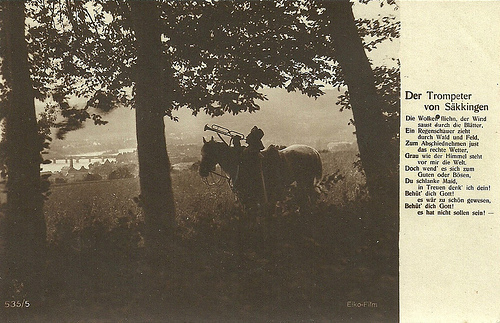
German postcard by Rotophot in the Series Film-Sterne, no. 535/5. Photo: Eiko-Film. Publicity still for Der Trompeter von Säkkingen (Franz Porten, 1918).
Five Years of Separation
Der Trompetter von Säkkingen was based on a popular German opera of the same name by Viktor Nessler. In turn, this opera was based on an extremely popular and widely released romantic epic poem by Joseph Victor von Scheffel, published in 1854. Sometimes book and opera are also written as Der Trompeter von Säckingen (sic). The story is set in Heidelberg and Säckingen during the 17th century, after the Thirty Years War. Law student, later trumpeter Werner Kirchhof (in the film played by Paul Hartmann) falls in love with Margareta, a baron's daughter (Leonore Oppermann), but her mother wants to marry her to the cowardly Damian. Werner proves to be a hero, and a compassionate pope makes him marquis of Camposanto. Then, after five years of separation, nothing prevents a happy ending.
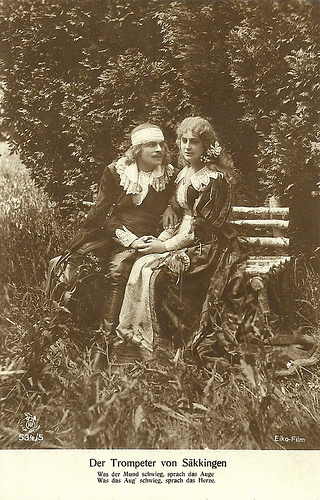
German postcard by Rotophot in the Series Film-Sterne, no. 534/5. Photo: Eiko-Film. Publicity still for Der Trompeter von Säkkingen (Franz Porten, 1918).
International Success
Rudolf Bunge wrote the libretto for the opera by Viktor Nessler. Der Trompetter von Säkkingen was first performed under Arthur Nikisch at the Carola Theater (or Stadttheater) in Leipzig, on 4 May 1884. It was Nessler's greatest success, albeit in part because of the popularity of Joseph Victor von Scheffel's work. It was subsequently given at the Metropolitan Opera in New York on 23 November 1887, and at the Theatre Royal, Drury Lane in London on 8 July 1892. A new chapter of the Trumpeter's Story began in 1918 when director Franz Porten made a silent film version for the Eiko studio. Porten wrote the story with Julius Urgiss and his daughter Rosa Porten. His other daughter, the film diva Henny Porten is said to have played a small part in the film ( IMDb and Filmportal.de both write that this is unconfirmed). Franz Porten moved from Berlin to Säckingen for the outdoor scenes, for which he used some 200 locals as extras. The images on the picture postcards that were produced for the film are very atmospheric.
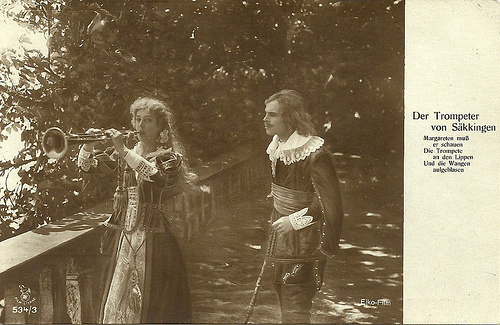
German postcard by Rotophot in the Series Film-Sterne, no. 534/3. Photo: Eiko-Film. Publicity still for Der Trompeter von Säkkingen (Franz Porten, 1918).
Sources: Official Der Trompeter von Säckingen site, Filmportal.de, Wikipedia and IMDb.

German postcard by Rotophot in the Series Film-Sterne, no. 535/5. Photo: Eiko-Film. Publicity still for Der Trompeter von Säkkingen (Franz Porten, 1918).
Five Years of Separation
Der Trompetter von Säkkingen was based on a popular German opera of the same name by Viktor Nessler. In turn, this opera was based on an extremely popular and widely released romantic epic poem by Joseph Victor von Scheffel, published in 1854. Sometimes book and opera are also written as Der Trompeter von Säckingen (sic). The story is set in Heidelberg and Säckingen during the 17th century, after the Thirty Years War. Law student, later trumpeter Werner Kirchhof (in the film played by Paul Hartmann) falls in love with Margareta, a baron's daughter (Leonore Oppermann), but her mother wants to marry her to the cowardly Damian. Werner proves to be a hero, and a compassionate pope makes him marquis of Camposanto. Then, after five years of separation, nothing prevents a happy ending.

German postcard by Rotophot in the Series Film-Sterne, no. 534/5. Photo: Eiko-Film. Publicity still for Der Trompeter von Säkkingen (Franz Porten, 1918).
International Success
Rudolf Bunge wrote the libretto for the opera by Viktor Nessler. Der Trompetter von Säkkingen was first performed under Arthur Nikisch at the Carola Theater (or Stadttheater) in Leipzig, on 4 May 1884. It was Nessler's greatest success, albeit in part because of the popularity of Joseph Victor von Scheffel's work. It was subsequently given at the Metropolitan Opera in New York on 23 November 1887, and at the Theatre Royal, Drury Lane in London on 8 July 1892. A new chapter of the Trumpeter's Story began in 1918 when director Franz Porten made a silent film version for the Eiko studio. Porten wrote the story with Julius Urgiss and his daughter Rosa Porten. His other daughter, the film diva Henny Porten is said to have played a small part in the film ( IMDb and Filmportal.de both write that this is unconfirmed). Franz Porten moved from Berlin to Säckingen for the outdoor scenes, for which he used some 200 locals as extras. The images on the picture postcards that were produced for the film are very atmospheric.

German postcard by Rotophot in the Series Film-Sterne, no. 534/3. Photo: Eiko-Film. Publicity still for Der Trompeter von Säkkingen (Franz Porten, 1918).
Sources: Official Der Trompeter von Säckingen site, Filmportal.de, Wikipedia and IMDb.
Published on July 18, 2013 23:00
July 17, 2013
Annette Vadim
Pouty-lipped, blonde Annette Vadim (1936-2005) was a Danish-born starlet and socialite. She was the second wife of Svengali-like French film director Roger Vadim, who tried unsuccessfully to turn her into another Brigitte Bardot. Yet, her brief film career included interesting films like Vadim's Les Liaisons Dangereuses (1959) and Et mourir de plaisir (1960), and Roberto Rossellini’s Anima near (1962).
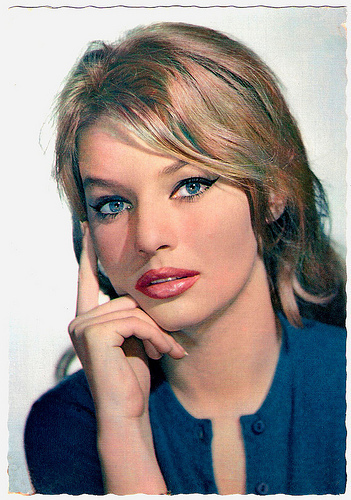
French postcard by E.D.U.G., Paris, no. 138. Photo: Sam Lévin.
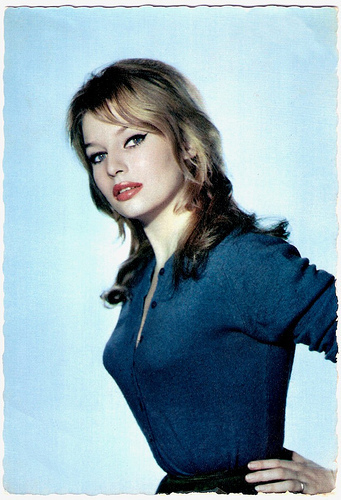
French postcard by M.D., Paris, no. 14. Photo: Sam Lévin.
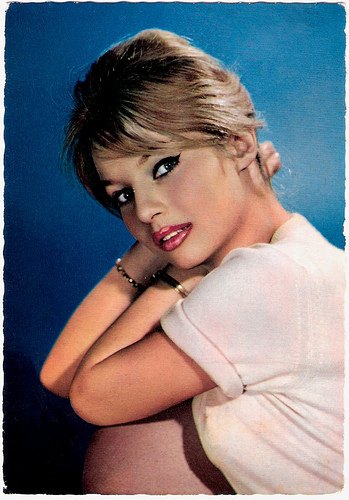
French postcard by E.D.U.G., Paris, no. 142. Sent by mail in 1961. Photo: Sam Lévin.
Laroche and Chanel
Annette Vadim was born as Annette Susanne Strøyberg in 1936 on Funen (Fyn Island), Denmark, also the birthplace of Hans Christian Andersen. She grew up under the Nazi occupation. Her father was a doctor, and after his death she and her sister moved to Copenhagen. As a schoolgirl, she was a fine athlete and a champion water skier, but it was her full-lipped beauty which attracted the attention of a passing photographer in the street. Until then, she had harboured hopes of medical school, but the photos launched her on a career as a model. In her late teens she went to Paris to become a mannequin for Guy Laroche, who had just opened his couture house, and she later worked for Chanel, amongst others. At the age of 21, she met director Roger Vadim during the production of Les bijoutiers du clair de lune/The Night Heaven Fell (Roger Vadim, 1958) who was then at the height of his notoriety following the release of Et Dieu... créa la femme/And God Created Woman (1956) starring Brigitte Bardot. (Some sources like The Guardian claim they met during the production of Et Dieu... créa la femme). Vadim fell in love with the sexy young blonde from Denmark. Les bijoutiers du clair de lune starred Bardot, who Vadim divorced in December 1957. One day later his daughter with Stroyberg, Nadine, was born. Vadim and Stroyberg married in June 1958.
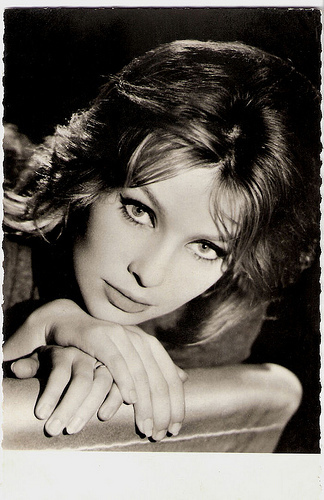
French postcard by Editions P.I., Paris, no. 15 L. Photo: Lucienne Chevert.
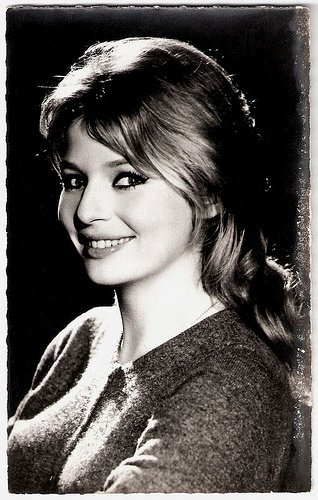
French postcard by E.D.U.G., Paris, no. 828. Photo: Lucienne Chevert.
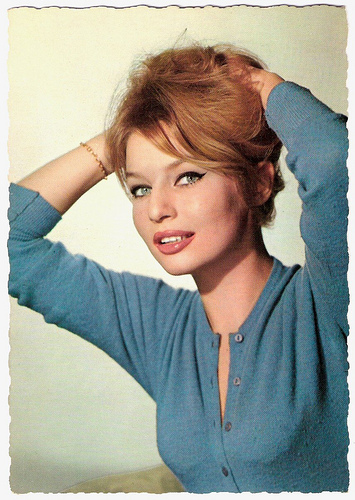
French postcard by E.D.U.G., Paris, no. 68. Photo: Sam Lévin.
Not The New BB
According to the obituary writer at the The Times “of the five wives of Roger Vadim, Annette Stroyberg had perhaps to labour hardest to escape his shadow. Although her ingénue’s sensuality and blonde mane led the press to hail her as the ‘new BB’ when she replaced Brigitte Bardot in the director’s affections in the late 1950s, she was at that time neither a natural creature of the limelight like her predecessor, nor a full-blown star like Jane Fonda and Catherine Deneuve, nor an heiress like Catherine Schneider.” She made two films with her husband. Les liaisons dangereuses/Dangerous Love Affairs (1959, Roger Vadim) was an ironic updated version of Choderlos de Laclos' 1782 novel of the same name. She played Marianne de Tourvel, the virtuous prey of the evil Jeanne Moreau and Gérard Philipe. According to Gary Brumburgh at IMDb Annette looked "stunning of course" in her debut, but she “found herself quite outclassed by her cast, hardly ready for such a demanding role.” More successful was her work in the vampire film Et mourir de plaisir/Blood and Roses (1960), based on the classic Sheridan Le Fanu tale Carmilla, cast as the society girl-cum-lesbian blood-sucking seductress. In her 2007 review of the film at Cinebeats , Kimberly Lindbergs writes: “I personally find Blood and Roses to be one of the most influential and important horror films ever made, and possibly Roger Vadim’s best movie. (…) Vadim infused Blood and Roses with a high-level of eroticism that had rarely, if ever, been present in previous horror films made earlier and his personal retelling of Le Fanu’s Carmilla would go on to spawn a legion of similar films.” About Annette Vadim, Lindbergs comments: “She brings a vulnerability and sadness to her role of Carmilla that is hard to forget. She also shares a fascinating chemistry with her lovely co-star Elsa Martinelli.”
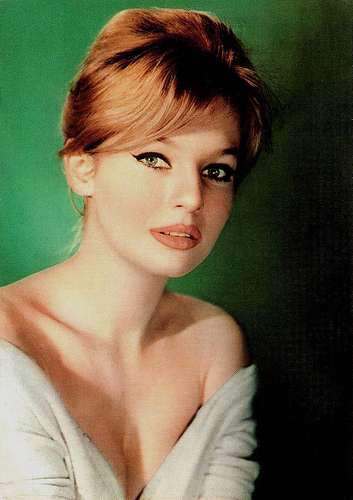
Italian postcard by Rotalfoto, Milano, no. 111. Photo: Sam Lévin.
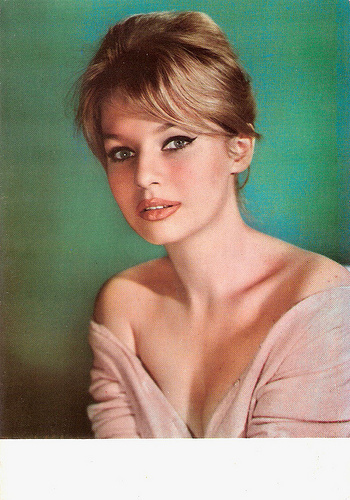
French postcard by Editions P.I., Paris, no. 1026. Photo: Sam Lévin.
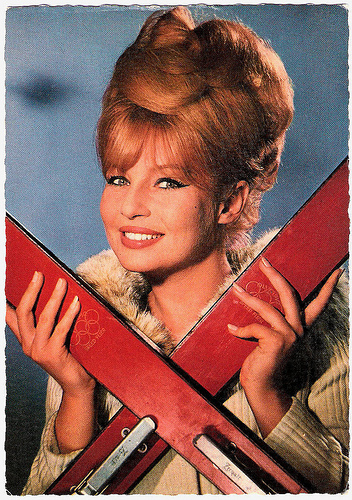
French postcard by E.D.U.G., Paris, no. 387. Photo: Sam Lévin.
Sorbonne
By the time of the release of Et mourir de plaisir, the marriage of Annette and Roger Vadim was already over and they divorced in 1960. He moved on to Catherine Deneuve, she initially to singer-actor Sacha Distel. Subsequently she packed her bags and moved to Italy. As Annette Stroyberg, she made a handful of films under contract to Dino de Laurentiis, most notably the comedy Il carabiniere a cavallo/The Mounted Police (Carlo Lizzani, 1961) with Nino Manfredi, and Anima near/Black Soul (Roberto Rossellini, 1962). In the latter starred Vittorio Gassman as the black soul of the title, a wealthy bourgeois married to Stroyberg. However, when his past catches up with him - he had survived the war by seducing an SS officer - she walks out in disgust. Privately she was also linked for a couple of years to Gassman and she also had affairs with Alain Delon, Omar Sharif, and Warren Beatty. By the mid-1960‘s, however, she had had more than enough of the film world and its values. Her last film was Lo scippo/The Motorcycle Theft (Nando Cicero, 1965) with Gabriele Ferzetti and Margaret Lee. She married a French Moroccan, and enrolled at the Sorbonne university. She divided her time between Paris and North Africa. When this marriage also came to an end, she moved to America, where she later married a Greek shipping magnate, Gregory Callimanopulos. According to The Times : “after the break-up of her third marriage, Stroyberg returned to Europe in the early 1990‘s, living in Paris and Copenhagen, where she was part of the circle around Queen Margrethe and Prince Henrik. She was also close to Bardot, whom she visited often in the South of France, a certain difference in their political outlook notwithstanding.” All Vadim’s wives attended his funeral in 2000. Three years later Annette Stroyberg published a memoir which sold well in Denmark and France. At age 69, she died of cancer in Copenhagen, Denmark, in 2005. Her three children (one from each of her marriages) survived her. Her daughter by Vadim, Nathalie Vadim, became an assistant director of films and worked on her father's remake of And God Created Woman (Roger Vadim, 1988) starring Rebecca De Mornay.
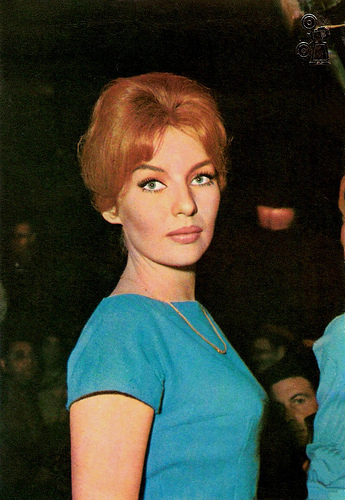
Spanish postcard by Postalcolor, Barcelona, no. 106, 1964. Photo: Sirman Press.
American trailer of Et mourir de plaisir/Blood and Roses (1960). Source: TrailerFood (YouTube).
Scene from Et mourir de plaisir/Blood and Roses (1960). Source: Guy Conrad (YouTube).
Sources: Ronald Bergan (The Guardian), Kimberly Lindbergs (Cinebeats), (IMDb), The Times, Wikipedia and .

French postcard by E.D.U.G., Paris, no. 138. Photo: Sam Lévin.

French postcard by M.D., Paris, no. 14. Photo: Sam Lévin.

French postcard by E.D.U.G., Paris, no. 142. Sent by mail in 1961. Photo: Sam Lévin.
Laroche and Chanel
Annette Vadim was born as Annette Susanne Strøyberg in 1936 on Funen (Fyn Island), Denmark, also the birthplace of Hans Christian Andersen. She grew up under the Nazi occupation. Her father was a doctor, and after his death she and her sister moved to Copenhagen. As a schoolgirl, she was a fine athlete and a champion water skier, but it was her full-lipped beauty which attracted the attention of a passing photographer in the street. Until then, she had harboured hopes of medical school, but the photos launched her on a career as a model. In her late teens she went to Paris to become a mannequin for Guy Laroche, who had just opened his couture house, and she later worked for Chanel, amongst others. At the age of 21, she met director Roger Vadim during the production of Les bijoutiers du clair de lune/The Night Heaven Fell (Roger Vadim, 1958) who was then at the height of his notoriety following the release of Et Dieu... créa la femme/And God Created Woman (1956) starring Brigitte Bardot. (Some sources like The Guardian claim they met during the production of Et Dieu... créa la femme). Vadim fell in love with the sexy young blonde from Denmark. Les bijoutiers du clair de lune starred Bardot, who Vadim divorced in December 1957. One day later his daughter with Stroyberg, Nadine, was born. Vadim and Stroyberg married in June 1958.

French postcard by Editions P.I., Paris, no. 15 L. Photo: Lucienne Chevert.

French postcard by E.D.U.G., Paris, no. 828. Photo: Lucienne Chevert.

French postcard by E.D.U.G., Paris, no. 68. Photo: Sam Lévin.
Not The New BB
According to the obituary writer at the The Times “of the five wives of Roger Vadim, Annette Stroyberg had perhaps to labour hardest to escape his shadow. Although her ingénue’s sensuality and blonde mane led the press to hail her as the ‘new BB’ when she replaced Brigitte Bardot in the director’s affections in the late 1950s, she was at that time neither a natural creature of the limelight like her predecessor, nor a full-blown star like Jane Fonda and Catherine Deneuve, nor an heiress like Catherine Schneider.” She made two films with her husband. Les liaisons dangereuses/Dangerous Love Affairs (1959, Roger Vadim) was an ironic updated version of Choderlos de Laclos' 1782 novel of the same name. She played Marianne de Tourvel, the virtuous prey of the evil Jeanne Moreau and Gérard Philipe. According to Gary Brumburgh at IMDb Annette looked "stunning of course" in her debut, but she “found herself quite outclassed by her cast, hardly ready for such a demanding role.” More successful was her work in the vampire film Et mourir de plaisir/Blood and Roses (1960), based on the classic Sheridan Le Fanu tale Carmilla, cast as the society girl-cum-lesbian blood-sucking seductress. In her 2007 review of the film at Cinebeats , Kimberly Lindbergs writes: “I personally find Blood and Roses to be one of the most influential and important horror films ever made, and possibly Roger Vadim’s best movie. (…) Vadim infused Blood and Roses with a high-level of eroticism that had rarely, if ever, been present in previous horror films made earlier and his personal retelling of Le Fanu’s Carmilla would go on to spawn a legion of similar films.” About Annette Vadim, Lindbergs comments: “She brings a vulnerability and sadness to her role of Carmilla that is hard to forget. She also shares a fascinating chemistry with her lovely co-star Elsa Martinelli.”

Italian postcard by Rotalfoto, Milano, no. 111. Photo: Sam Lévin.

French postcard by Editions P.I., Paris, no. 1026. Photo: Sam Lévin.

French postcard by E.D.U.G., Paris, no. 387. Photo: Sam Lévin.
Sorbonne
By the time of the release of Et mourir de plaisir, the marriage of Annette and Roger Vadim was already over and they divorced in 1960. He moved on to Catherine Deneuve, she initially to singer-actor Sacha Distel. Subsequently she packed her bags and moved to Italy. As Annette Stroyberg, she made a handful of films under contract to Dino de Laurentiis, most notably the comedy Il carabiniere a cavallo/The Mounted Police (Carlo Lizzani, 1961) with Nino Manfredi, and Anima near/Black Soul (Roberto Rossellini, 1962). In the latter starred Vittorio Gassman as the black soul of the title, a wealthy bourgeois married to Stroyberg. However, when his past catches up with him - he had survived the war by seducing an SS officer - she walks out in disgust. Privately she was also linked for a couple of years to Gassman and she also had affairs with Alain Delon, Omar Sharif, and Warren Beatty. By the mid-1960‘s, however, she had had more than enough of the film world and its values. Her last film was Lo scippo/The Motorcycle Theft (Nando Cicero, 1965) with Gabriele Ferzetti and Margaret Lee. She married a French Moroccan, and enrolled at the Sorbonne university. She divided her time between Paris and North Africa. When this marriage also came to an end, she moved to America, where she later married a Greek shipping magnate, Gregory Callimanopulos. According to The Times : “after the break-up of her third marriage, Stroyberg returned to Europe in the early 1990‘s, living in Paris and Copenhagen, where she was part of the circle around Queen Margrethe and Prince Henrik. She was also close to Bardot, whom she visited often in the South of France, a certain difference in their political outlook notwithstanding.” All Vadim’s wives attended his funeral in 2000. Three years later Annette Stroyberg published a memoir which sold well in Denmark and France. At age 69, she died of cancer in Copenhagen, Denmark, in 2005. Her three children (one from each of her marriages) survived her. Her daughter by Vadim, Nathalie Vadim, became an assistant director of films and worked on her father's remake of And God Created Woman (Roger Vadim, 1988) starring Rebecca De Mornay.

Spanish postcard by Postalcolor, Barcelona, no. 106, 1964. Photo: Sirman Press.
American trailer of Et mourir de plaisir/Blood and Roses (1960). Source: TrailerFood (YouTube).
Scene from Et mourir de plaisir/Blood and Roses (1960). Source: Guy Conrad (YouTube).
Sources: Ronald Bergan (The Guardian), Kimberly Lindbergs (Cinebeats), (IMDb), The Times, Wikipedia and .
Published on July 17, 2013 23:00
July 16, 2013
Paul Hubschmid
In the 1930s, Paul Hubschmid (1917-2002) was the first Swiss film star. Then he became a popular leading man in the cinema of Nazi-Germany. During the late 1940s and early 1950s he worked in Hollywood as Paul Christian. Later on he was dubbed 'the most beautiful man in post-war German cinema', and he was still playing romantic leads in the early 1960s.
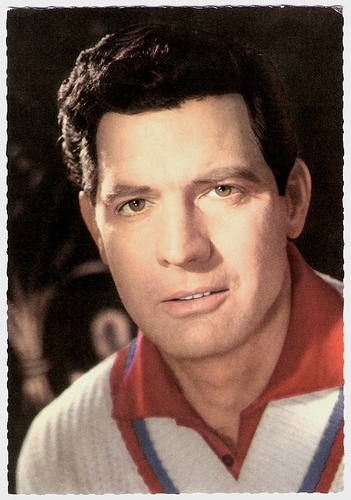
German postcard by ISV, no. M 18. Photo: Gabriele / Real / Europa-Film.
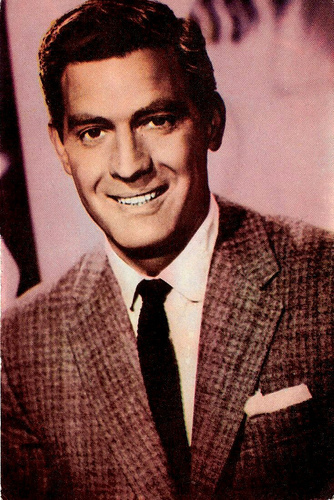
Postcard by Cox, no. 4.
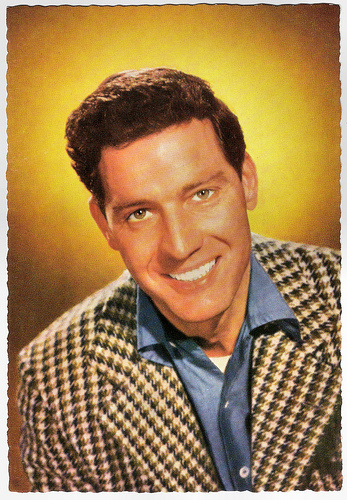
German postcard by WS-Druck, Wanne-Eickel, no. F 94. Photo: Ringpress.
Virile Good Looks
Paul Hugo Hubschmid was born in Schönenwerd in Switzerland in 1917. He was the son of an accountant. In 1937 he graduated from the Max-Reinhardt-Seminar in Vienna and made his stage debut at the local Deutschen Volkstheater (German People's Theatre). The following year he played his first film role in the Swiss production Füsilier Wipf/Infanterist Wipf (Hermann Haller, Leopold Lindtberg, 1938). This film made him famous overnight, and he became very popular in both Switzerland and Germany. Another Swiss production, Die missbrauchten Liebesbriefe/The Abused Love Letters (Leopold Lindtberg, 1940) followed, but later he worked mainly in Nazi-Germany. Till the end of the war he appeared in such films as Meine Freundin Josefine/My Friend Josephine (Hans H. Zerlett, 1942), Liebesbriefe/Love Letters (Hans H. Zerlett, 1944), and Der gebieterische Ruf/The Commanding Call (Gustav Ucicky, 1944). After the war Hubschmid became a popular leading man in films like Gottes Engel sind überall/Angels of God Are Everywhere (Hans Thimig, 1948) and Geheimnisvolle Tiefe/The Mysterious Deep (Georg Wilhelm Pabst, 1949). Universal brought him to Hollywood despite his film work in the Nazi period. Renamed as Paul Christian he played the dashing hero of the adventure movies Bagdad (Charles Lamont, 1949) with Maureen O'Hara and Vincent Price, and Il ladro di Venezia/The Thief of Venice (John Brahm, 1950) next to Maria Montez. His virile good looks compensated for a stiff acting style, according to American critics. He also starred in the classic monster movie The Beast from 20,000 Fathoms (Eugène Lourié, 1953). In his obituary about Hubschmid in the The Independent , Tom Vallance wrote: "Based on Ray Bradbury's haunting short story The Foghorn, the film spawned so many cheap imitations that it is surprising now to realise that it was the first film to deal with a prehistoric monster unearthed by an atomic explosion and going on a rampage through a major city. Christian was effective enough as the scientist who first realises the truth but is not believed, but it was Eugène Lourié's atmospheric direction and in particular the splendid special effects of Ray Harryhausen that turned the $250,000 film into a hit that grossed $5m."
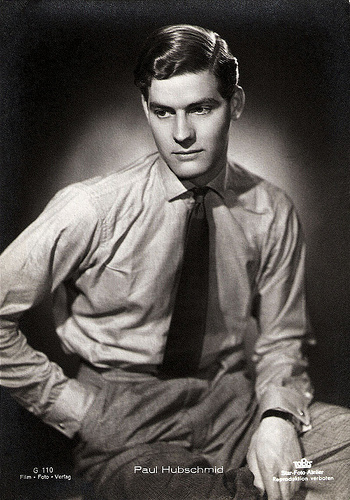
German postcard by Film-Foto-Verlag, no. G 110, 1941-1944. Photo: Star-Foto-Atelier / Tobis.
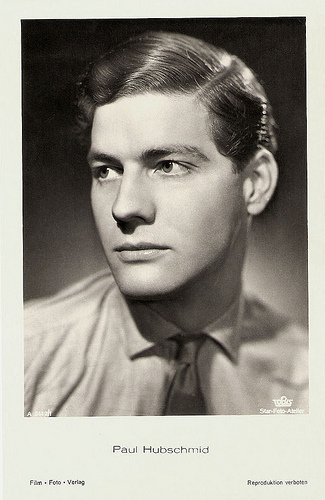
German postcard by Film-Foto-Verlag, no. A 3442/1, 1941-1944. Photo: Star-Foto-Atelier / Tobis.
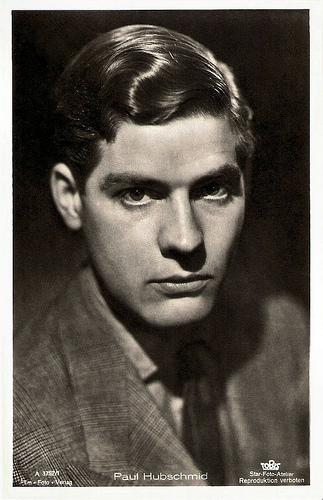
German postcard by Film-Foto-Verlag, no. A 3752/1, 1941-1944. Photo: Star-Foto-Atelier / Tobis.
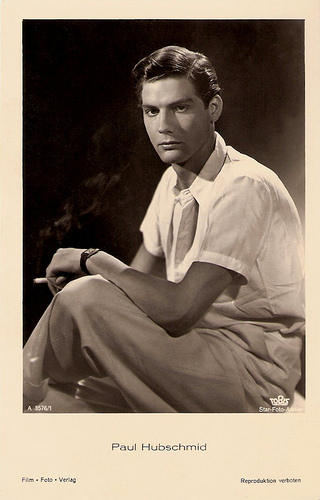
German postcard by Film-Foto-Verlag, no. A 3576/1, 1941-1944. Photo: Star-Foto-Atelier / Tobis.
Beautiful Man, What Now?
In 1953 Paul Hubschmid returned to Germany to play leads in Maske in Blau/Mask in Blue (Georg Jacoby, 1953) with Marika Rökk, Musik bei Nacht/Music by Night (Kurt Hoffmann, 1953) with Curd Jürgens, Salzburger Geschichten/Chronicles of Salzburg (Kurt Hoffmann, 1957) with Marianne Koch, and Die Zürcher Verlobung/The Zurich Engagement (Helmut Käutner, 1957) with Liselotte Pulver. He usually appeared as a handsome charmer or a swashbuckling action hero. Very popular was the romantic comedy Scampolo (Alfred Weidenmann, 1958) starring Romy Schneider. Successful were also the remakes of the exotic adventure epic Der Tiger von Eschnapur/The Tiger of Eschnapur (1959) and its sequel Das Indische Grabmal/The Indian Tomb (1959), both directed by Fritz Lang. Later Paul Hubschmid won praise as a fine character player in such international productions as the spy thriller Funeral in Berlin (Guy Hamilton, 1966) as a former black-market crony of spy Harry Palmer (Michael Caine), and A Taste of Excitement (Don Sharp, 1969). He appeared more than 2000 times on the German and Austrian stages as Henry Higgins in My Fair Lady. In the 1970s and 1980s he worked mainly for TV. The Swiss production Klassäzämekunft (Walter Deuber, Peter Stierlin, 1988) brought together many popular Swiss stars and was a kind of homage to former heydays. His last film was the comedy Linda (Ottokar Runze, 1992). He used to say that he wondered if his looks had not been detrimental to his acting career, and he entitled his 1994 autobiography Schöner Mann, was nun? (Beautiful Man, What Now?). From 1942 till her death in 1963 he was married with actress Ursula von Teubern. In 1967 he married film actress Eva Renzi. Their marriage was dissolved in 1980. In 1985 he married Irene Schiesser. When Paul Hubschmid died in 2001 in Berlin at the age of 84, he had made over 120 films.
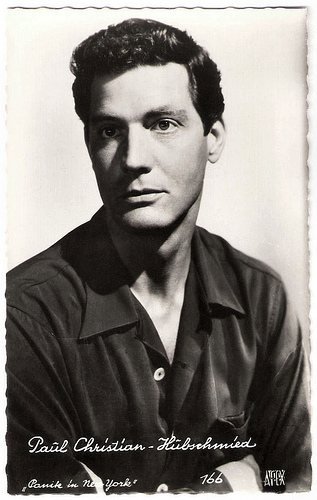
Austrian postcard by Verlag Hubmann (HDH Verlag), Wien, no. 166. Photo: Afex. Publicity still for The Beast from 20,000 Fathoms (Eugène Lourié, 1953).
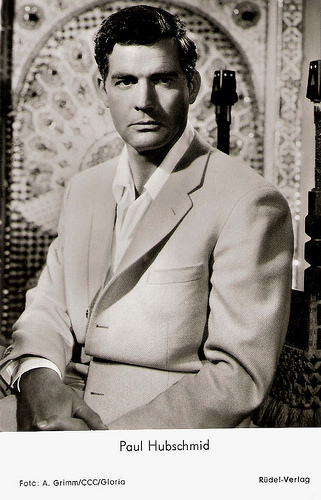
German postcard by Rüdel-Verlag, no. 2616. Photo: Arthur Grimm / CCC / Gloria. Publicity still for Der Tiger von Eschnapur/The Tiger of Eschnapur (Fritz Lang, 1959).
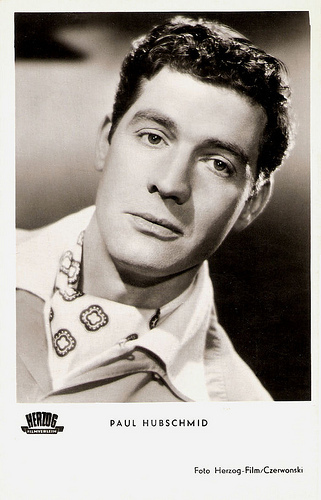
German postcard by Kunst und Bild, no. I 465. Photo: Czerwonski / Herzog-Film.
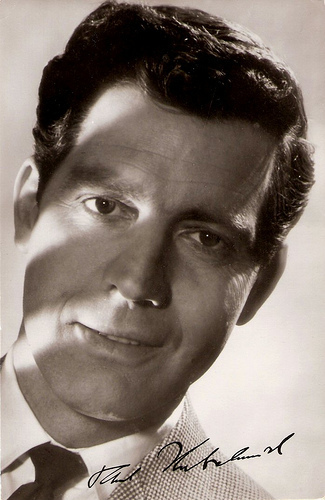
East-German postcard by VEB Progress Film-Vertrieb, Berlin, no. P 83/504, 1957. Retail price: 0,20 DM. Photo: Real-Film / Michaelis.
Sources: Tom Vallance (The Independent), Thomas Staedeli (Cyranos), and Wikipedia and .

German postcard by ISV, no. M 18. Photo: Gabriele / Real / Europa-Film.

Postcard by Cox, no. 4.

German postcard by WS-Druck, Wanne-Eickel, no. F 94. Photo: Ringpress.
Virile Good Looks
Paul Hugo Hubschmid was born in Schönenwerd in Switzerland in 1917. He was the son of an accountant. In 1937 he graduated from the Max-Reinhardt-Seminar in Vienna and made his stage debut at the local Deutschen Volkstheater (German People's Theatre). The following year he played his first film role in the Swiss production Füsilier Wipf/Infanterist Wipf (Hermann Haller, Leopold Lindtberg, 1938). This film made him famous overnight, and he became very popular in both Switzerland and Germany. Another Swiss production, Die missbrauchten Liebesbriefe/The Abused Love Letters (Leopold Lindtberg, 1940) followed, but later he worked mainly in Nazi-Germany. Till the end of the war he appeared in such films as Meine Freundin Josefine/My Friend Josephine (Hans H. Zerlett, 1942), Liebesbriefe/Love Letters (Hans H. Zerlett, 1944), and Der gebieterische Ruf/The Commanding Call (Gustav Ucicky, 1944). After the war Hubschmid became a popular leading man in films like Gottes Engel sind überall/Angels of God Are Everywhere (Hans Thimig, 1948) and Geheimnisvolle Tiefe/The Mysterious Deep (Georg Wilhelm Pabst, 1949). Universal brought him to Hollywood despite his film work in the Nazi period. Renamed as Paul Christian he played the dashing hero of the adventure movies Bagdad (Charles Lamont, 1949) with Maureen O'Hara and Vincent Price, and Il ladro di Venezia/The Thief of Venice (John Brahm, 1950) next to Maria Montez. His virile good looks compensated for a stiff acting style, according to American critics. He also starred in the classic monster movie The Beast from 20,000 Fathoms (Eugène Lourié, 1953). In his obituary about Hubschmid in the The Independent , Tom Vallance wrote: "Based on Ray Bradbury's haunting short story The Foghorn, the film spawned so many cheap imitations that it is surprising now to realise that it was the first film to deal with a prehistoric monster unearthed by an atomic explosion and going on a rampage through a major city. Christian was effective enough as the scientist who first realises the truth but is not believed, but it was Eugène Lourié's atmospheric direction and in particular the splendid special effects of Ray Harryhausen that turned the $250,000 film into a hit that grossed $5m."

German postcard by Film-Foto-Verlag, no. G 110, 1941-1944. Photo: Star-Foto-Atelier / Tobis.

German postcard by Film-Foto-Verlag, no. A 3442/1, 1941-1944. Photo: Star-Foto-Atelier / Tobis.

German postcard by Film-Foto-Verlag, no. A 3752/1, 1941-1944. Photo: Star-Foto-Atelier / Tobis.

German postcard by Film-Foto-Verlag, no. A 3576/1, 1941-1944. Photo: Star-Foto-Atelier / Tobis.
Beautiful Man, What Now?
In 1953 Paul Hubschmid returned to Germany to play leads in Maske in Blau/Mask in Blue (Georg Jacoby, 1953) with Marika Rökk, Musik bei Nacht/Music by Night (Kurt Hoffmann, 1953) with Curd Jürgens, Salzburger Geschichten/Chronicles of Salzburg (Kurt Hoffmann, 1957) with Marianne Koch, and Die Zürcher Verlobung/The Zurich Engagement (Helmut Käutner, 1957) with Liselotte Pulver. He usually appeared as a handsome charmer or a swashbuckling action hero. Very popular was the romantic comedy Scampolo (Alfred Weidenmann, 1958) starring Romy Schneider. Successful were also the remakes of the exotic adventure epic Der Tiger von Eschnapur/The Tiger of Eschnapur (1959) and its sequel Das Indische Grabmal/The Indian Tomb (1959), both directed by Fritz Lang. Later Paul Hubschmid won praise as a fine character player in such international productions as the spy thriller Funeral in Berlin (Guy Hamilton, 1966) as a former black-market crony of spy Harry Palmer (Michael Caine), and A Taste of Excitement (Don Sharp, 1969). He appeared more than 2000 times on the German and Austrian stages as Henry Higgins in My Fair Lady. In the 1970s and 1980s he worked mainly for TV. The Swiss production Klassäzämekunft (Walter Deuber, Peter Stierlin, 1988) brought together many popular Swiss stars and was a kind of homage to former heydays. His last film was the comedy Linda (Ottokar Runze, 1992). He used to say that he wondered if his looks had not been detrimental to his acting career, and he entitled his 1994 autobiography Schöner Mann, was nun? (Beautiful Man, What Now?). From 1942 till her death in 1963 he was married with actress Ursula von Teubern. In 1967 he married film actress Eva Renzi. Their marriage was dissolved in 1980. In 1985 he married Irene Schiesser. When Paul Hubschmid died in 2001 in Berlin at the age of 84, he had made over 120 films.

Austrian postcard by Verlag Hubmann (HDH Verlag), Wien, no. 166. Photo: Afex. Publicity still for The Beast from 20,000 Fathoms (Eugène Lourié, 1953).

German postcard by Rüdel-Verlag, no. 2616. Photo: Arthur Grimm / CCC / Gloria. Publicity still for Der Tiger von Eschnapur/The Tiger of Eschnapur (Fritz Lang, 1959).

German postcard by Kunst und Bild, no. I 465. Photo: Czerwonski / Herzog-Film.

East-German postcard by VEB Progress Film-Vertrieb, Berlin, no. P 83/504, 1957. Retail price: 0,20 DM. Photo: Real-Film / Michaelis.
Sources: Tom Vallance (The Independent), Thomas Staedeli (Cyranos), and Wikipedia and .
Published on July 16, 2013 23:00
July 15, 2013
Gisèle Pascal
Gisèle Pascal (1921-2007) was an attractive French film actress and a lover of Rainier III, Prince of Monaco.
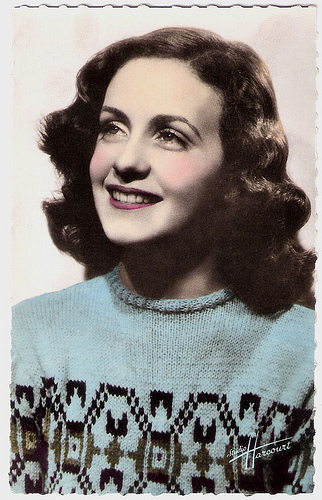
French postcard by O.P., Paris, no. 34. Photo: Studio Harcourt.
Beautiful Ingénue
Gisèle (sometimes Giselle) Pascal was born Gisèle Marie Madeleine Tallone in Cannes, France in 1921. She studied shorthand and typing and intended to become a secretary, but she also attended dance classes. She was spotted by the film director Marc Allégret, who recommended her to actor-director Claude Dauphin, with whom she made her stage début. Allégret also cast her in L'Arlésienne/The Girl from Arles (Marc Allégret, 1942), based on Alphonse Daudet's play of the same name. Her co-stars were the popular comedian Raimu and the young Louis Jourdan. Raimu reportedly loved the Provençal accent of the beautiful ingénue. She also appeared in Allégret’s La belle aventure/Twilight (Marc Allégret, 1942) starring Claude Dauphin and Micheline Presle. She also appeared with María Denis and Louis Jourdan in La vie de bohème/ Bohemian life (Marcel L’Herbier, 1945). After the war, she played lead parts in such melodramas as Tombé du ciel/Dropped From Heaven (Emil E. Reinert, 1946) and Dernier refuge/Last Refuge (Alex Joffé, 1947). The latter, based on Le Locataire (The Lodger) by Georges Simenon, wasn't successful. She also starred in such musical comedies as Mademoiselle s'amuse/Mademoiselle has Fun (Jean Boyer, 1948) and La Petite chocolatière/The Chocolate Girl (André Berthomieu, 1950), with Claude Dauphin.
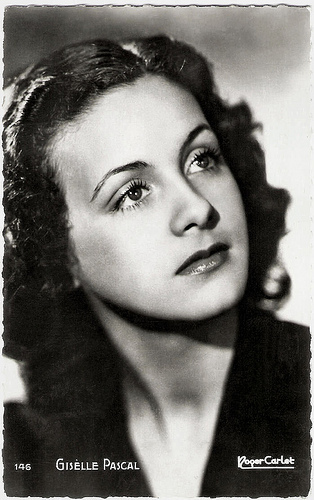
French postcard by Editions P.I., no. 146, La Garenne Colombes, offered by Les Carbones Korés Carboplane, no. 55. Photo: Roger Carlet.
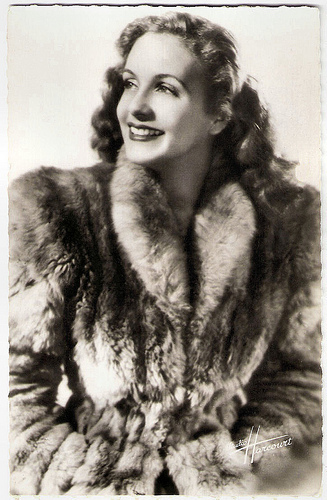
French postcard by O.P., Paris, no. 241. Photo: Studio Harcourt, Paris.
A Royal Affair
For ten years, Gisèle Pascal had a royal affair with Prince Rainier. Pierre Perrone in The Independent : “Pascal had caught the eye of Rainier when he was a student at Montpellier University during the Second World War and she was treading the boards in boulevard plays. For a time, the couple openly shared a villa in Saint-Jean-Cap-Ferrat on the French Riviera when she wasn't away in Paris filming. There was even talk of marriage but, when Rainier ascended to the throne of the tiny principality in 1949 after the death of his father, Prince Louis II, his relationship with Pascal came under increasing pressure and eventually floundered.” Meddlesome Princess Antoinette, Rainier's older sister, seeking to obtain the throne of Monaco for her own son, spread malicious rumours that Pascal was incapable of bearing children. A contemplated marriage was called off when a medical examination claimed that she was infertile. Perrone: “Snobbery certainly also played a part in Rainier's wavering and eventual decision, since Pascal came from humble Italian stock and had worked in her parents' grocery as a child.” After her break-up with Rainier, she made one of her best films, Horizons sans fin/Endless Horizons (Jean Dreville, 1953) with Jean Chevrier. She portrayed the French pilot Hélène Boucher, who held seven world records and died in a plane crash in 1934. Hal Erickson at AllMovie : “Though the world of aviation was still essentially an all-male one (despite England's Amy Johnson and America's Amelia Earhart), Boucher perseveres, eventually breaking all existing male and female speed and height records. A bit slow on the uptake in the dramatic scenes, the film soars (no pun intended) during the aerial sequences. Horizons san Fin was the winner of the Catholic Award at the 1953 Cannes Film Festival.” Pascal took flying lessons to add credibility to her performance as Boucher. While promoting Horizons sans fin in Cannes, she met Hollywood star Gary Cooper. The couple became the talk of the festival but their affair ended when the actor's wife and daughter joined him in Paris a few weeks later.
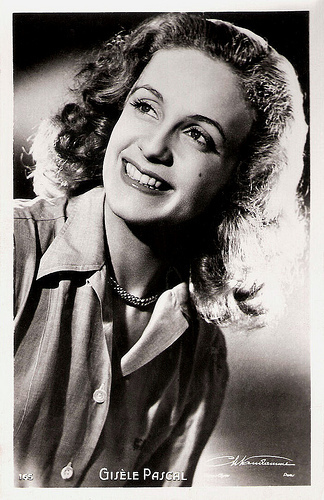
French postcard by P.I., Paris, no. 165, presented by Les Carbones Korès 'Carboplane'. Photo: Ch. Vandamme, Paris.
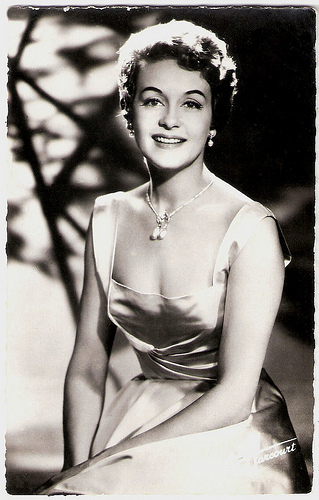
French postcard by Editions du Globe, no. 797. Photo: Studio Harcourt, Paris.
Social Realism
In 1954, Gisèle Pascal winked to her affair with the Prince with her appearances in the historical drama Si Versailles m'était conté/Royal Affairs in Versailles (Sacha Guitry, 1954) which portrayed the personalities who lived in the Royal Palace, the Chateau of Versailles. She also appeared in the sequel, Si Paris nous était conté/If Paris Were Told to Us (Sacha Guitry, 1956). In 1955, she married actor Raymond Pellegrin. They had worked together on the ‘social realism’ dramas Le Feu dans la peau/Fire Under the Skin (Marcel Blistène, 1953) and Marchandes d'illusions/Women Without Shame (Raoul André, 1954) . Previously she had had a crush on Pellegrin when they had both appeared in the same play, but he was married to actress Dora Doll. However, their friendship blossomed into a relationship, and after his divorce they married. In 1962, they would have a daughter, actress Pascale Pellegrin. She returned to the screen in Le Masque de fer/The Iron Mask (Henri Decoin, 1962) inspired by the novels by Alexandre Dumas. Jean Marais played the aging d’Artagnan on his mission to rescue the imprisoned brother of Louis XIV. After taking a break from radio, theatre and film work in the 1970s, she played character parts in En haut des marches/At the Top of the Stairs (Paul Vecchiali, 1983) starring Danielle Darrieux, the comedy Les Compères/The fellows (Francis Veber, 1983) featuring Pierre Richard and Gérard Depardieu and remade in the US as Fathers' Day (1997), the drama La Femme publique/The Public Woman (Andrzej Zulawski, 1983), and Juillet en septembre/July in September (Sébastien Japrisot, 1988). She also acted in several television series in France and Germany. Gisèle Pascal died in 2007 in Nîmes, France. She was 85.
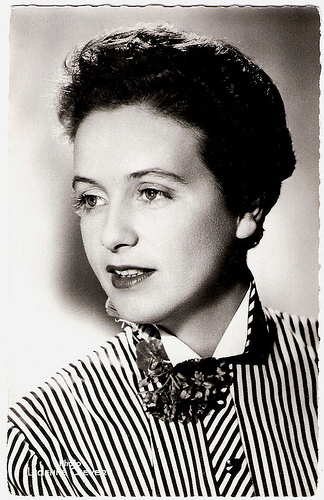
French postcard by Editions du Globe, Paris. Photo: Lucienne Chevert.
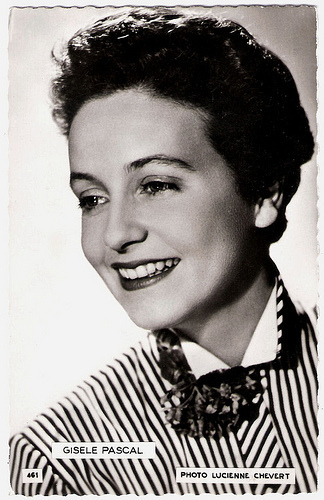
French postcard by P.I., Paris, no. 461. Photo: Lucienne Chevert.
Sources: Pierre Perrone (The Independent), Hal Erickson (AllMovie), CinéMémorial (French), AllMovie, Wikipedia, and .

French postcard by O.P., Paris, no. 34. Photo: Studio Harcourt.
Beautiful Ingénue
Gisèle (sometimes Giselle) Pascal was born Gisèle Marie Madeleine Tallone in Cannes, France in 1921. She studied shorthand and typing and intended to become a secretary, but she also attended dance classes. She was spotted by the film director Marc Allégret, who recommended her to actor-director Claude Dauphin, with whom she made her stage début. Allégret also cast her in L'Arlésienne/The Girl from Arles (Marc Allégret, 1942), based on Alphonse Daudet's play of the same name. Her co-stars were the popular comedian Raimu and the young Louis Jourdan. Raimu reportedly loved the Provençal accent of the beautiful ingénue. She also appeared in Allégret’s La belle aventure/Twilight (Marc Allégret, 1942) starring Claude Dauphin and Micheline Presle. She also appeared with María Denis and Louis Jourdan in La vie de bohème/ Bohemian life (Marcel L’Herbier, 1945). After the war, she played lead parts in such melodramas as Tombé du ciel/Dropped From Heaven (Emil E. Reinert, 1946) and Dernier refuge/Last Refuge (Alex Joffé, 1947). The latter, based on Le Locataire (The Lodger) by Georges Simenon, wasn't successful. She also starred in such musical comedies as Mademoiselle s'amuse/Mademoiselle has Fun (Jean Boyer, 1948) and La Petite chocolatière/The Chocolate Girl (André Berthomieu, 1950), with Claude Dauphin.

French postcard by Editions P.I., no. 146, La Garenne Colombes, offered by Les Carbones Korés Carboplane, no. 55. Photo: Roger Carlet.

French postcard by O.P., Paris, no. 241. Photo: Studio Harcourt, Paris.
A Royal Affair
For ten years, Gisèle Pascal had a royal affair with Prince Rainier. Pierre Perrone in The Independent : “Pascal had caught the eye of Rainier when he was a student at Montpellier University during the Second World War and she was treading the boards in boulevard plays. For a time, the couple openly shared a villa in Saint-Jean-Cap-Ferrat on the French Riviera when she wasn't away in Paris filming. There was even talk of marriage but, when Rainier ascended to the throne of the tiny principality in 1949 after the death of his father, Prince Louis II, his relationship with Pascal came under increasing pressure and eventually floundered.” Meddlesome Princess Antoinette, Rainier's older sister, seeking to obtain the throne of Monaco for her own son, spread malicious rumours that Pascal was incapable of bearing children. A contemplated marriage was called off when a medical examination claimed that she was infertile. Perrone: “Snobbery certainly also played a part in Rainier's wavering and eventual decision, since Pascal came from humble Italian stock and had worked in her parents' grocery as a child.” After her break-up with Rainier, she made one of her best films, Horizons sans fin/Endless Horizons (Jean Dreville, 1953) with Jean Chevrier. She portrayed the French pilot Hélène Boucher, who held seven world records and died in a plane crash in 1934. Hal Erickson at AllMovie : “Though the world of aviation was still essentially an all-male one (despite England's Amy Johnson and America's Amelia Earhart), Boucher perseveres, eventually breaking all existing male and female speed and height records. A bit slow on the uptake in the dramatic scenes, the film soars (no pun intended) during the aerial sequences. Horizons san Fin was the winner of the Catholic Award at the 1953 Cannes Film Festival.” Pascal took flying lessons to add credibility to her performance as Boucher. While promoting Horizons sans fin in Cannes, she met Hollywood star Gary Cooper. The couple became the talk of the festival but their affair ended when the actor's wife and daughter joined him in Paris a few weeks later.

French postcard by P.I., Paris, no. 165, presented by Les Carbones Korès 'Carboplane'. Photo: Ch. Vandamme, Paris.

French postcard by Editions du Globe, no. 797. Photo: Studio Harcourt, Paris.
Social Realism
In 1954, Gisèle Pascal winked to her affair with the Prince with her appearances in the historical drama Si Versailles m'était conté/Royal Affairs in Versailles (Sacha Guitry, 1954) which portrayed the personalities who lived in the Royal Palace, the Chateau of Versailles. She also appeared in the sequel, Si Paris nous était conté/If Paris Were Told to Us (Sacha Guitry, 1956). In 1955, she married actor Raymond Pellegrin. They had worked together on the ‘social realism’ dramas Le Feu dans la peau/Fire Under the Skin (Marcel Blistène, 1953) and Marchandes d'illusions/Women Without Shame (Raoul André, 1954) . Previously she had had a crush on Pellegrin when they had both appeared in the same play, but he was married to actress Dora Doll. However, their friendship blossomed into a relationship, and after his divorce they married. In 1962, they would have a daughter, actress Pascale Pellegrin. She returned to the screen in Le Masque de fer/The Iron Mask (Henri Decoin, 1962) inspired by the novels by Alexandre Dumas. Jean Marais played the aging d’Artagnan on his mission to rescue the imprisoned brother of Louis XIV. After taking a break from radio, theatre and film work in the 1970s, she played character parts in En haut des marches/At the Top of the Stairs (Paul Vecchiali, 1983) starring Danielle Darrieux, the comedy Les Compères/The fellows (Francis Veber, 1983) featuring Pierre Richard and Gérard Depardieu and remade in the US as Fathers' Day (1997), the drama La Femme publique/The Public Woman (Andrzej Zulawski, 1983), and Juillet en septembre/July in September (Sébastien Japrisot, 1988). She also acted in several television series in France and Germany. Gisèle Pascal died in 2007 in Nîmes, France. She was 85.

French postcard by Editions du Globe, Paris. Photo: Lucienne Chevert.

French postcard by P.I., Paris, no. 461. Photo: Lucienne Chevert.
Sources: Pierre Perrone (The Independent), Hal Erickson (AllMovie), CinéMémorial (French), AllMovie, Wikipedia, and .
Published on July 15, 2013 23:00
July 14, 2013
Victor Boucher
Victor Boucher (1877–1942) was a French stage and screen actor, who was popular as a comedian of the early French sound ccinema.
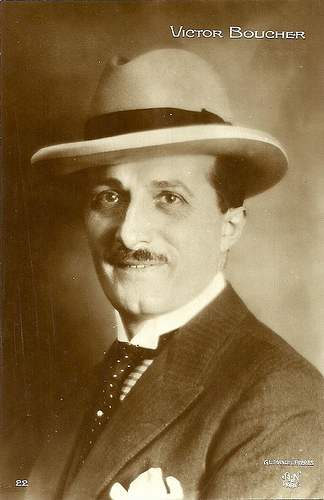
French postcard by A.N., Paris, no. 22. Photo: G.L. Manuel Frères.
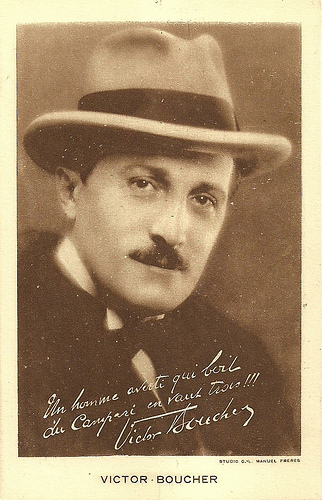
French postcard for Campari. Photo: Studio G.L. Manuel Frères. Caption: "Un homme averti qui boit du Campari en vaut trois!!!" (A man forewarned who drinks Campari equals three).
Talent as a Comedian
Victor Louis Armand Boucher was born 24 August 1877 in Rouen in a house in the Rue Saint-Étienne-des-Tonneliers. His parents ran a café-restaurant at Bihorel. After attending school at Rouen, he debuted on stage at the Cercle de jeunesse. After working as a bookkeeper in Rouen and doing his military service, he moved to Paris. Probably his first part he got was in the play Thermidor at the Comédie Française in 1891. He married Mariotta Claire at Neufchâtel-en-Bray in 1902. In 1905 he was lucky to replace an ill actor at the Théâtre des Mathurins with the play Nono and soon he became known for his talent as a comedian, performing from 1905 till 1907 at the Theatre de Vaudeville, from 1907 till 1908 at the Theatre de la Renaissance and so on.
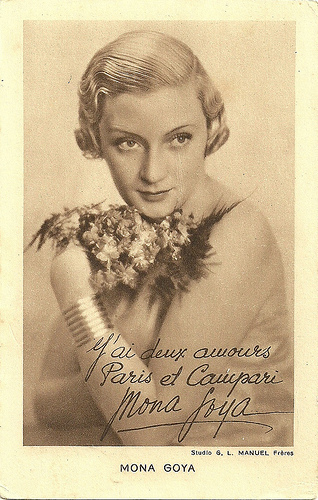
Mona Goya. French postcard for Campari. Photo: Studio G.L. Manuel Frères. Caption: "J'ai deux amours Paris et Campari." (I have two loves, Paris and Campari).
Prolific Film Actor
In 1913 Victor Boucher also started to act in film. he appeared first in La Petite Chocolatière (1913) by André Liabel, followed by L'Idée de Françoise by Emile Chautard. However, in the 1920s he was foremost a stage actor, first mostly at the Théâtre du Gymnase, later at the Théâtre de la Michodière. In 1927 Boucher became the manager of Théâtre de la Michodière, which became his fixed theatre between the late 1920s and 1940. Boucher also became chair of the Association des artistes dramatiques. When sound film arrived in France, Boucher became a prolific film actor there as well. Between 1930 and 1941, he mostly played in light comedies that are now all forgotten. They didn't make it into he canon of French film history, such as Robert Siodmak's comedy Le sexe faible (1933). Here Boucher is a stylish butler who is involved in the intrigues of his patrons. He acted oppositie Mona Goya in La Banque Némo (Marguerite Viel, 1934). In the late 1930s Boucher was often paired with Elvire Popesco. Victor Boucher died in 1942 in Ville-d'Avray, France.
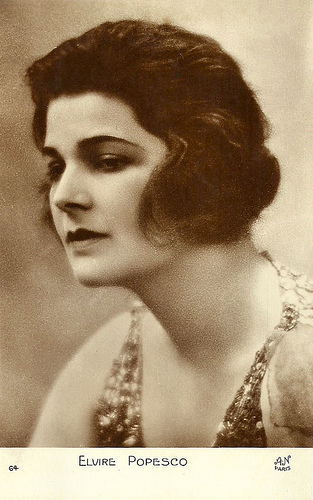
Elvire Popesco. French postcard by A.N., Paris, no. 64.
Sources: Wikipedia (French and English), and .

French postcard by A.N., Paris, no. 22. Photo: G.L. Manuel Frères.

French postcard for Campari. Photo: Studio G.L. Manuel Frères. Caption: "Un homme averti qui boit du Campari en vaut trois!!!" (A man forewarned who drinks Campari equals three).
Talent as a Comedian
Victor Louis Armand Boucher was born 24 August 1877 in Rouen in a house in the Rue Saint-Étienne-des-Tonneliers. His parents ran a café-restaurant at Bihorel. After attending school at Rouen, he debuted on stage at the Cercle de jeunesse. After working as a bookkeeper in Rouen and doing his military service, he moved to Paris. Probably his first part he got was in the play Thermidor at the Comédie Française in 1891. He married Mariotta Claire at Neufchâtel-en-Bray in 1902. In 1905 he was lucky to replace an ill actor at the Théâtre des Mathurins with the play Nono and soon he became known for his talent as a comedian, performing from 1905 till 1907 at the Theatre de Vaudeville, from 1907 till 1908 at the Theatre de la Renaissance and so on.

Mona Goya. French postcard for Campari. Photo: Studio G.L. Manuel Frères. Caption: "J'ai deux amours Paris et Campari." (I have two loves, Paris and Campari).
Prolific Film Actor
In 1913 Victor Boucher also started to act in film. he appeared first in La Petite Chocolatière (1913) by André Liabel, followed by L'Idée de Françoise by Emile Chautard. However, in the 1920s he was foremost a stage actor, first mostly at the Théâtre du Gymnase, later at the Théâtre de la Michodière. In 1927 Boucher became the manager of Théâtre de la Michodière, which became his fixed theatre between the late 1920s and 1940. Boucher also became chair of the Association des artistes dramatiques. When sound film arrived in France, Boucher became a prolific film actor there as well. Between 1930 and 1941, he mostly played in light comedies that are now all forgotten. They didn't make it into he canon of French film history, such as Robert Siodmak's comedy Le sexe faible (1933). Here Boucher is a stylish butler who is involved in the intrigues of his patrons. He acted oppositie Mona Goya in La Banque Némo (Marguerite Viel, 1934). In the late 1930s Boucher was often paired with Elvire Popesco. Victor Boucher died in 1942 in Ville-d'Avray, France.

Elvire Popesco. French postcard by A.N., Paris, no. 64.
Sources: Wikipedia (French and English), and .
Published on July 14, 2013 23:00
July 13, 2013
Jean-Hugues Anglade
French actor Jean-Hugues Anglade (1955) is internationally best known for his sensual and ambiguous roles in the cult films 37°2 le matin/Betty Blue (1986) and Nikita/La Femme Nikita (1990).
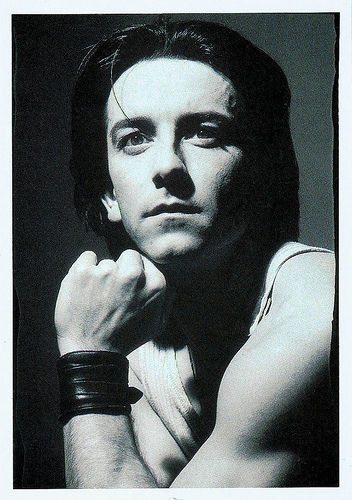
French postcard by Humour a la Carte, Paris, no. ST-164. Photo: J. Casano / Stills.
Revelation
Jean-Hugues Anglade was born in Thouars, France in 1955. His father was a veterinary and his mother a social worker. He studied five years at the Conservatoire national supérieur d'art dramatique in Paris. After some TV performances, he made his film debut with a supporting part in the crime film L'indiscrétion/The indiscretion (Pierre Lary, 1982) starring Jean Rochefort. He was a revelation as a young man discovering his homosexuality in l'Homme blessé/The Wounded Man (Patrice Chéreau, 1983), written by Chéreau and Hervé Guibert. James Travers at Films de France : “The film stars Jean-Hugues Anglade in what remains his most courageous and striking screen role, playing the taciturn mixed-up adolescent Henri with so much conviction that it is hard to believe he is enacting a fictional piece of drama. Anglade pours everything he has into this performance and the film’s impact rests mainly on his sympathetic portrayal of Henri as a vulnerable victim of his own tragic humanity.“ The dark and quite raw film won the César Award for Best Writing and was also entered into the 1983 Cannes Film Festival. Anglade played a supporting part in La diagonale du fou/Dangerous Moves (Richard Dembo, 1984), starring Michel Piccoli. The film about two very different men competing in the final match of the World Chess Championship won the Academy Award for Best Foreign Language Film, the Prix Louis Delluc, and the César Award for Best Debut. Anglade then had a part as a roller skating bag snatcher in Luc Besson’s Subway (1985) starring Isabelle Adjani and Christophe Lambert. The film is now regarded as part of the Cinema du look movement and was the third most popular French film in France in 1986. Anglade’s definitive breakthrough came with 37°2 le matin/Betty Blue (Jean-Jacques Beineix, 1986). Betty (Béatrice Dalle in her debut role) and Zorg (Anglade) are passionate lovers who live in a shack on the beach. Betty's free-spirited nature and devotion to handyman Zorg develop into alarming obsession, aggression and destructiveness, and the film alternates between comedy and tragedy. Betty Blue received both a BAFTA and Oscar nomination for Best Foreign Language Film in 1986. Four years later Anglade played Anne Parillaud’s boyfriend in another international hit, Nikita/La Femme Nikita (Luc Besson, 1990). This action thriller centres around a punkish, psychotic, and drug-ridden girl who is recruited to work as an assassin for the French government. Brendon Hanley at AllMovie : “writer/director Luc Besson's rhythmic, ultra-stylish, and gleefully ridiculous 1990 hit movie. A mixture of Pygmalion, Diva, and one of John Woo's choreographed action pictures, the film was one of a subgenre of action pictures to emerge in the 1990s, characterized by tongue-in-cheek stylistics and a hip, film noir-ish sensibility.”
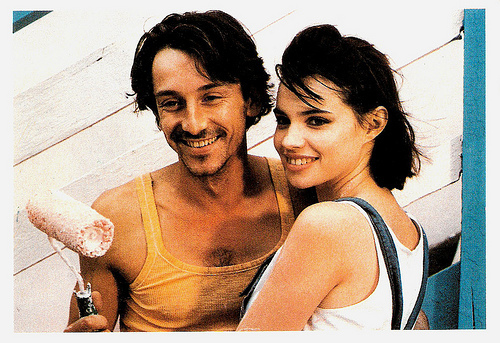
French postcard by Ebulittions, no. 16. Photo: publicity still for 37°2 le matin/Betty Blue (1986) with Béatrice Dalle.
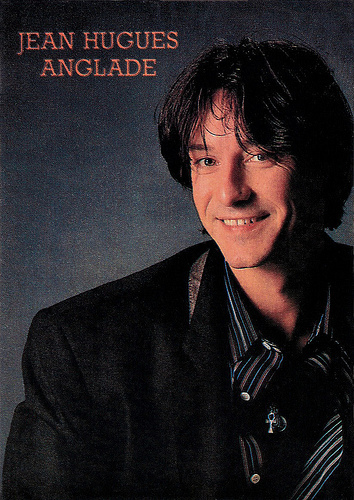
Vintage postcard.
Remarkable Turn
Jean-Hugues Anglade reunited with Patrice Chéreau for the lavish historical epic La Reine Margot/Queen Margot (1994), based on the novel by Alexandre Dumas, père. The film starring Isabelle Adjani was an international box office success, and won the Jury Prize and Best Actress Award at the 1994 Cannes Film Festival, as well as five César Awards in 1995. For his part as the doomed King Charles IX, Anglade was awarded the César for Best Actor in a Supporting Role. He co-starred with Eric Stoltz and Julie Delpy in Killing Zoe (Roger Avary, 1994) about a doomed bank heist. Despite being set in Paris, the film was shot almost entirely in Los Angeles. Killing Zoe was at the time a box-office disaster but is now regarded as a cult film. In the following years Anglade made films in both Europe and the US, including Nelly et Monsieur Arnaud/Nelly and Mr. Arnaud (Claude Sautet, 1995) with Michel Serrault and Emmanuelle Béart, the action film Maximum Risk (Ringo Lam, 1996), starring Jean-Claude Van Damme and Natasha Henstridge, and the Italian-French comedy Le affinità elettive/The Elective Affinities (Paolo and Vittorio Taviani, 1996) with Isabelle Huppert. Anglade wrote and directed himself the film Tonka (1996), with his partner Pamela Soo in the lead. The film was not a success. In the following decade his films were less prominent. Beineix’ Franco-German comedy-thriller Mortel Transfert (Jean-Jacques Beineix, 2001) was an artistic disappointment and a major commercial failure. He had supporting parts in the Italian drama Il più bel giorno della mia vita/The Best Day of My Life (Cristina Comencini, 2002) with Virna Lisi, the Hollywood thriller Taking Lives (D. J. Caruso, 2004) starring Angelina Jolie, and the war drama Shake Hands with the Devil (Roger Spottiswoode, 2007). Then he came back with leading roles in a series of interesting films. He played the lead in the drama Il prossimo tuo/Thy Neighbour (Anne Riitta Ciccone, 2008). In another good drama, Villa Amalia (Benoît Jacquot, 2009) he co-starred again with Isabelle Huppert. In Persécution (Patrice Chéreau, 2009) he played a madman who spies on and haunts Romain Duris. For his role, Anglade won the César Award for Best Supporting Actor. He also made a remarkable turn on French television in an instalment of Collection Fred Vargas titled Sous les vents de Neptune (2009). Recently, he appeared in the comedy Amitiés sincères/Kind regards (Stéphan Archinard, François Prévôt-Leygonie, 2012) with Gérard Lanvin, and the crime film L'autre vie de Richard Kemp/Back in Crime (Germinal Alvarez, 2013). Jean-Hugues Anglade has two sons, Pierre-Louis and Emile, with ex-companion Mali Lecomte.
Trailer 37°2 le matin/Betty Blue (Director's Cut)(1986/2009). Source: Watchculturetainment (YouTube).
French trailer Nikita/La Femme Nikita (1990). Source: Putois blogueur (YouTube).
Sources: James Travers (Films de France), Brendon Hanley (AllMovie), Yuri German (AllMovie), Wikipedia (French and English) and .

French postcard by Humour a la Carte, Paris, no. ST-164. Photo: J. Casano / Stills.
Revelation
Jean-Hugues Anglade was born in Thouars, France in 1955. His father was a veterinary and his mother a social worker. He studied five years at the Conservatoire national supérieur d'art dramatique in Paris. After some TV performances, he made his film debut with a supporting part in the crime film L'indiscrétion/The indiscretion (Pierre Lary, 1982) starring Jean Rochefort. He was a revelation as a young man discovering his homosexuality in l'Homme blessé/The Wounded Man (Patrice Chéreau, 1983), written by Chéreau and Hervé Guibert. James Travers at Films de France : “The film stars Jean-Hugues Anglade in what remains his most courageous and striking screen role, playing the taciturn mixed-up adolescent Henri with so much conviction that it is hard to believe he is enacting a fictional piece of drama. Anglade pours everything he has into this performance and the film’s impact rests mainly on his sympathetic portrayal of Henri as a vulnerable victim of his own tragic humanity.“ The dark and quite raw film won the César Award for Best Writing and was also entered into the 1983 Cannes Film Festival. Anglade played a supporting part in La diagonale du fou/Dangerous Moves (Richard Dembo, 1984), starring Michel Piccoli. The film about two very different men competing in the final match of the World Chess Championship won the Academy Award for Best Foreign Language Film, the Prix Louis Delluc, and the César Award for Best Debut. Anglade then had a part as a roller skating bag snatcher in Luc Besson’s Subway (1985) starring Isabelle Adjani and Christophe Lambert. The film is now regarded as part of the Cinema du look movement and was the third most popular French film in France in 1986. Anglade’s definitive breakthrough came with 37°2 le matin/Betty Blue (Jean-Jacques Beineix, 1986). Betty (Béatrice Dalle in her debut role) and Zorg (Anglade) are passionate lovers who live in a shack on the beach. Betty's free-spirited nature and devotion to handyman Zorg develop into alarming obsession, aggression and destructiveness, and the film alternates between comedy and tragedy. Betty Blue received both a BAFTA and Oscar nomination for Best Foreign Language Film in 1986. Four years later Anglade played Anne Parillaud’s boyfriend in another international hit, Nikita/La Femme Nikita (Luc Besson, 1990). This action thriller centres around a punkish, psychotic, and drug-ridden girl who is recruited to work as an assassin for the French government. Brendon Hanley at AllMovie : “writer/director Luc Besson's rhythmic, ultra-stylish, and gleefully ridiculous 1990 hit movie. A mixture of Pygmalion, Diva, and one of John Woo's choreographed action pictures, the film was one of a subgenre of action pictures to emerge in the 1990s, characterized by tongue-in-cheek stylistics and a hip, film noir-ish sensibility.”

French postcard by Ebulittions, no. 16. Photo: publicity still for 37°2 le matin/Betty Blue (1986) with Béatrice Dalle.

Vintage postcard.
Remarkable Turn
Jean-Hugues Anglade reunited with Patrice Chéreau for the lavish historical epic La Reine Margot/Queen Margot (1994), based on the novel by Alexandre Dumas, père. The film starring Isabelle Adjani was an international box office success, and won the Jury Prize and Best Actress Award at the 1994 Cannes Film Festival, as well as five César Awards in 1995. For his part as the doomed King Charles IX, Anglade was awarded the César for Best Actor in a Supporting Role. He co-starred with Eric Stoltz and Julie Delpy in Killing Zoe (Roger Avary, 1994) about a doomed bank heist. Despite being set in Paris, the film was shot almost entirely in Los Angeles. Killing Zoe was at the time a box-office disaster but is now regarded as a cult film. In the following years Anglade made films in both Europe and the US, including Nelly et Monsieur Arnaud/Nelly and Mr. Arnaud (Claude Sautet, 1995) with Michel Serrault and Emmanuelle Béart, the action film Maximum Risk (Ringo Lam, 1996), starring Jean-Claude Van Damme and Natasha Henstridge, and the Italian-French comedy Le affinità elettive/The Elective Affinities (Paolo and Vittorio Taviani, 1996) with Isabelle Huppert. Anglade wrote and directed himself the film Tonka (1996), with his partner Pamela Soo in the lead. The film was not a success. In the following decade his films were less prominent. Beineix’ Franco-German comedy-thriller Mortel Transfert (Jean-Jacques Beineix, 2001) was an artistic disappointment and a major commercial failure. He had supporting parts in the Italian drama Il più bel giorno della mia vita/The Best Day of My Life (Cristina Comencini, 2002) with Virna Lisi, the Hollywood thriller Taking Lives (D. J. Caruso, 2004) starring Angelina Jolie, and the war drama Shake Hands with the Devil (Roger Spottiswoode, 2007). Then he came back with leading roles in a series of interesting films. He played the lead in the drama Il prossimo tuo/Thy Neighbour (Anne Riitta Ciccone, 2008). In another good drama, Villa Amalia (Benoît Jacquot, 2009) he co-starred again with Isabelle Huppert. In Persécution (Patrice Chéreau, 2009) he played a madman who spies on and haunts Romain Duris. For his role, Anglade won the César Award for Best Supporting Actor. He also made a remarkable turn on French television in an instalment of Collection Fred Vargas titled Sous les vents de Neptune (2009). Recently, he appeared in the comedy Amitiés sincères/Kind regards (Stéphan Archinard, François Prévôt-Leygonie, 2012) with Gérard Lanvin, and the crime film L'autre vie de Richard Kemp/Back in Crime (Germinal Alvarez, 2013). Jean-Hugues Anglade has two sons, Pierre-Louis and Emile, with ex-companion Mali Lecomte.
Trailer 37°2 le matin/Betty Blue (Director's Cut)(1986/2009). Source: Watchculturetainment (YouTube).
French trailer Nikita/La Femme Nikita (1990). Source: Putois blogueur (YouTube).
Sources: James Travers (Films de France), Brendon Hanley (AllMovie), Yuri German (AllMovie), Wikipedia (French and English) and .
Published on July 13, 2013 23:00
July 12, 2013
Rudolf Platte
German character actor Rudolf Platte (1904-1984) played both cheerfully talkative and reserved and shy, but loving people in more than 200 films. After his death, the media hailed him as Berlin’s ‘last true folk actor’.
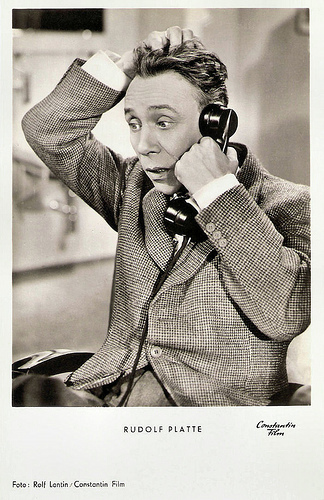
German postcard by Kunst und Bild, Berlin. Photo: Rolf Lantin / Constantin-Film.
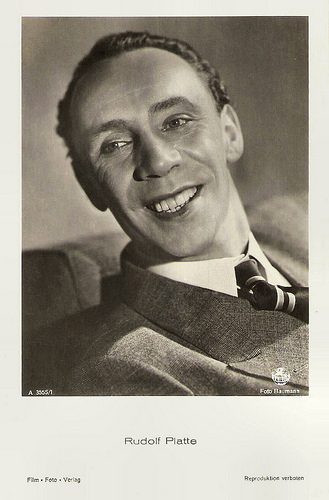
German postcard by Film-Foto-Verlag, no. A 3555/1, 1941-1944. Photo: Baumann / Terra.
Servants, Postmen and Small-time Crooks
Rudolf Antonius Heinrich Platte was born in Hörde in northern Germany in 1904. He was the son of the merchant Josef Platte and his wife Karoline. When he was three years old, his family moved to Hildesheim. Before his graduation, the 16-years old left school and took acting classes. Despite his young age, he made his stage debut in 1925 as Shylock in Der Kaufmann von Venedig (The Merchant of Venice) by William Shakespeare at the Freilichtbühne Düsseldorf. He gained more experience during engagements in Bad Harzburg, Hildesheim, Hagen, Wuppertal and at the Residenz Theater Hannover. He spent some time at the Lobe-Theater in Breslau (now Wroclaw), where he also directed several productions himself. In 1927 he came to Berlin, where he set up the cabaret 'Die Katakombe' (the catacomb) together with the political satirist, writer, and actor Werner Finck and the actor and director Hans Deppe. Die Katakombe was banned by the Nazis in 1935. His film debut was the youth drama Revolte im Erziehungshaus/Revolt in the Borstal (Georg Asagaroff, 1929) with Carl Balhaus. It was the start of a cinema career with more than 200 films. He often played roles of servants, postmen and small-time crooks: ordinary, reserved and shy, but loving people. German Wikipedia describes his character as ‘Mann von der Strasse’ (man of the street).
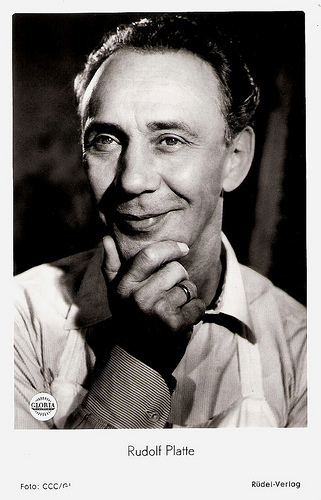
German postcard by Rüdel-Verlag. Photo: CCC / Gloria.
Rattling, Clumsy, Or Gloomy And Buffoonish
In the 1930s, Rudolf Platte also appeared in music revues in Berlin. His breakthrough was his performance in the revue Ein Kuß reist um die Welt (A kiss travels around the world) with Hilde Seipp and Aribert Mog. He played minor parts in a range of prestigious films, including F.P.1 antwortet nicht/F.P.1 Doesn't Answer (Karl Hartl, 1932), the cross dressing comedy Viktor und Viktoria/Viktor and Viktoria (Reinhold Schünzel, 1933) featuring Renate Müller, and the Science-fiction film Gold (Karl Hartl, 1934) starring Hans Albers and Brigitte Helm. He also appeared in one of the first Nazi propaganda films, Hitlerjunge Quex/Hitler Youth Quex (Hans Steinhoff, 1933). He was given the title role in Schützenkönig wird der Felix/Bashful Felix (Carl Boese, 1934). Another leading part was his final film role during the Nazi period, the criminologist Bruch in Der Meisterdetektiv/The Master Detective (Ernst Marischka, 1943). Between 1940 and 1944 he was director of the Theater in der Behrenstrasse, and from 1945 to 1947, he headed the Theater an Schiffbauerdamm. As an actor he could play both tragic and comic characters. During the 1950s he showed up in many entertainment films. These include the comedy Pension Schoeller (Georg Jacoby, 1952) starring Camilla Spira, the operetta Die Blume von Hawaii/Flower of Hawaii (Géza von Cziffra, 1953) with Maria Litto, and the comedy Columbus entdeckt Krähwinkel/Columbus Discovers Kraehwinkel (Ulrich Erfurth and Alexander Paal, 1954) starring Eva Kerbler and Charles Chaplin Jr. Filmportal.de : “Platte rarely starred in serious character roles like, for instance, in the role of the Czech refugee in Rolf Thiele’s film Mamitschka (1955) or in the role of 'Herr Wenzel' in Alfred Weidenmann’s film version of Die Buddenbrooks (The Buddenbrooks, 1959). Instead, Platte mainly played rattling, clumsy, or gloomy and buffoonish domestics, vagabonds, or petty crooks in entertainment films like Der Haustyrann (1959). Although these roles were well received by the audience, they did rarely meet his acting talents.”
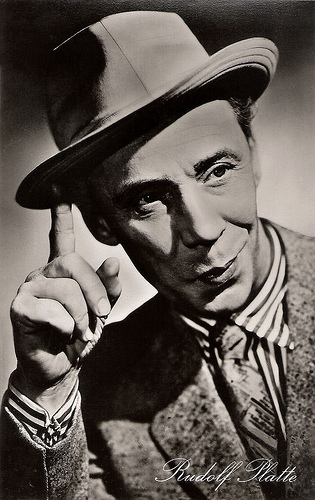
East-German postcard by VEB Progress Film-Vertrieb, no. 37/332, 1957. Retail price: 0,20 DM. Photo: Real-Film. Publicity still for Die tolle Lola/The great Lola (Hans Deppe, 1954).
Hippie Comedy
In 1964, Rudolf Platte co-starred with Götz George and Hans Nielsen in the war film Herrenpartie/Destination Death (Wolfgang Staudte, 1964) as a book dealer with a Nazi past. It was entered into the 14th Berlin International Film Festival. A curiosity was his leading part in the Dutch-German ‘hippie' comedy Professor Columbus (Rainer Erler, 1968) with Jeroen Krabbé. He rejoined with director Wolfgang Staudte for Die Herren mit der weißen Weste/Gentlemen in White Vests (1970) starring Martin Held. From the 1970s on, he often appeared on TV, both in popular Krimi shows like Der Kommisar/The Commissioner (1972-1975) and Derrick (1975-1977) as in demanding literary adaptations. On stage, Platte became one of Berlin’s most popular folk actors with the play Das Fenster zum Flur (Window to the corridor) by Curt Flatow and Horst Pillau. 278 times, he played his role as a gradually going blind streetcar driver at the Hebbel Theater. In 1982 he played his last film role in Die Sehnsucht der Veronika Voss/Veronika Voss (Rainer Werner Fassbinder, 1982). He played a melancholy Jewish pensioner who commits suicide alongside his wife (Johanna Hofer).Rudolf Platte married four times. His first wife was Vally Hager. Then he was briefly married to actress Georgia Lind. From 1942 till 1953, actress Marina Ried was his third wife. Then he remarried Georgia Lind. Thomas Staedeli at Cyranos : “After the death of Georgia Lind he lost his life courage and died only some days after his wife's death. The newspapers hailed him in 1984 as the ‘last true folk actor’. The childless Plattes bequeathed their combined assets of about two million Mark to the Hermann Gmeiner Fund to promote the SOS Children's Villages.
Sinalco Spot wit Platte. Source: SinalcoDeutschland (YouTube).
Trailer Das Fenster zum Flur Erik Ode, 1960) with Inge Meysel. Source: See Arr (YouTube).
Trailer Ihr schönster Tag (Paul Verhoeven, 1962. Source: See Arr (YouTube).
Sources: Thomas Staedeli (Cyranos), Stephanie d’Heil (Steffi-line) (German), The Concise Cinegraph / Filmportal.de, Wikipedia (German), and

German postcard by Kunst und Bild, Berlin. Photo: Rolf Lantin / Constantin-Film.

German postcard by Film-Foto-Verlag, no. A 3555/1, 1941-1944. Photo: Baumann / Terra.
Servants, Postmen and Small-time Crooks
Rudolf Antonius Heinrich Platte was born in Hörde in northern Germany in 1904. He was the son of the merchant Josef Platte and his wife Karoline. When he was three years old, his family moved to Hildesheim. Before his graduation, the 16-years old left school and took acting classes. Despite his young age, he made his stage debut in 1925 as Shylock in Der Kaufmann von Venedig (The Merchant of Venice) by William Shakespeare at the Freilichtbühne Düsseldorf. He gained more experience during engagements in Bad Harzburg, Hildesheim, Hagen, Wuppertal and at the Residenz Theater Hannover. He spent some time at the Lobe-Theater in Breslau (now Wroclaw), where he also directed several productions himself. In 1927 he came to Berlin, where he set up the cabaret 'Die Katakombe' (the catacomb) together with the political satirist, writer, and actor Werner Finck and the actor and director Hans Deppe. Die Katakombe was banned by the Nazis in 1935. His film debut was the youth drama Revolte im Erziehungshaus/Revolt in the Borstal (Georg Asagaroff, 1929) with Carl Balhaus. It was the start of a cinema career with more than 200 films. He often played roles of servants, postmen and small-time crooks: ordinary, reserved and shy, but loving people. German Wikipedia describes his character as ‘Mann von der Strasse’ (man of the street).

German postcard by Rüdel-Verlag. Photo: CCC / Gloria.
Rattling, Clumsy, Or Gloomy And Buffoonish
In the 1930s, Rudolf Platte also appeared in music revues in Berlin. His breakthrough was his performance in the revue Ein Kuß reist um die Welt (A kiss travels around the world) with Hilde Seipp and Aribert Mog. He played minor parts in a range of prestigious films, including F.P.1 antwortet nicht/F.P.1 Doesn't Answer (Karl Hartl, 1932), the cross dressing comedy Viktor und Viktoria/Viktor and Viktoria (Reinhold Schünzel, 1933) featuring Renate Müller, and the Science-fiction film Gold (Karl Hartl, 1934) starring Hans Albers and Brigitte Helm. He also appeared in one of the first Nazi propaganda films, Hitlerjunge Quex/Hitler Youth Quex (Hans Steinhoff, 1933). He was given the title role in Schützenkönig wird der Felix/Bashful Felix (Carl Boese, 1934). Another leading part was his final film role during the Nazi period, the criminologist Bruch in Der Meisterdetektiv/The Master Detective (Ernst Marischka, 1943). Between 1940 and 1944 he was director of the Theater in der Behrenstrasse, and from 1945 to 1947, he headed the Theater an Schiffbauerdamm. As an actor he could play both tragic and comic characters. During the 1950s he showed up in many entertainment films. These include the comedy Pension Schoeller (Georg Jacoby, 1952) starring Camilla Spira, the operetta Die Blume von Hawaii/Flower of Hawaii (Géza von Cziffra, 1953) with Maria Litto, and the comedy Columbus entdeckt Krähwinkel/Columbus Discovers Kraehwinkel (Ulrich Erfurth and Alexander Paal, 1954) starring Eva Kerbler and Charles Chaplin Jr. Filmportal.de : “Platte rarely starred in serious character roles like, for instance, in the role of the Czech refugee in Rolf Thiele’s film Mamitschka (1955) or in the role of 'Herr Wenzel' in Alfred Weidenmann’s film version of Die Buddenbrooks (The Buddenbrooks, 1959). Instead, Platte mainly played rattling, clumsy, or gloomy and buffoonish domestics, vagabonds, or petty crooks in entertainment films like Der Haustyrann (1959). Although these roles were well received by the audience, they did rarely meet his acting talents.”

East-German postcard by VEB Progress Film-Vertrieb, no. 37/332, 1957. Retail price: 0,20 DM. Photo: Real-Film. Publicity still for Die tolle Lola/The great Lola (Hans Deppe, 1954).
Hippie Comedy
In 1964, Rudolf Platte co-starred with Götz George and Hans Nielsen in the war film Herrenpartie/Destination Death (Wolfgang Staudte, 1964) as a book dealer with a Nazi past. It was entered into the 14th Berlin International Film Festival. A curiosity was his leading part in the Dutch-German ‘hippie' comedy Professor Columbus (Rainer Erler, 1968) with Jeroen Krabbé. He rejoined with director Wolfgang Staudte for Die Herren mit der weißen Weste/Gentlemen in White Vests (1970) starring Martin Held. From the 1970s on, he often appeared on TV, both in popular Krimi shows like Der Kommisar/The Commissioner (1972-1975) and Derrick (1975-1977) as in demanding literary adaptations. On stage, Platte became one of Berlin’s most popular folk actors with the play Das Fenster zum Flur (Window to the corridor) by Curt Flatow and Horst Pillau. 278 times, he played his role as a gradually going blind streetcar driver at the Hebbel Theater. In 1982 he played his last film role in Die Sehnsucht der Veronika Voss/Veronika Voss (Rainer Werner Fassbinder, 1982). He played a melancholy Jewish pensioner who commits suicide alongside his wife (Johanna Hofer).Rudolf Platte married four times. His first wife was Vally Hager. Then he was briefly married to actress Georgia Lind. From 1942 till 1953, actress Marina Ried was his third wife. Then he remarried Georgia Lind. Thomas Staedeli at Cyranos : “After the death of Georgia Lind he lost his life courage and died only some days after his wife's death. The newspapers hailed him in 1984 as the ‘last true folk actor’. The childless Plattes bequeathed their combined assets of about two million Mark to the Hermann Gmeiner Fund to promote the SOS Children's Villages.
Sinalco Spot wit Platte. Source: SinalcoDeutschland (YouTube).
Trailer Das Fenster zum Flur Erik Ode, 1960) with Inge Meysel. Source: See Arr (YouTube).
Trailer Ihr schönster Tag (Paul Verhoeven, 1962. Source: See Arr (YouTube).
Sources: Thomas Staedeli (Cyranos), Stephanie d’Heil (Steffi-line) (German), The Concise Cinegraph / Filmportal.de, Wikipedia (German), and
Published on July 12, 2013 23:00
Lisette Lanvin
Pretty Lisette Lanvin (1913-2004) had a nice career in the French cinema of the 1930s. She appeared in the debut of Marcel Carné and in two films by Sacha Guitry.
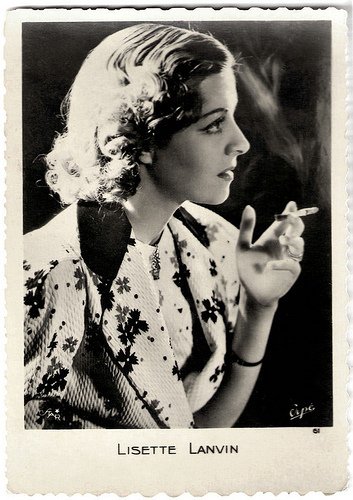
French postcard by Erpé, Paris, no. 61. Photo: Star.
Full of Surprises
Lisette Lanvin was born Elisabeth Etiennette Marie Caremil in Grasse, France in 1913. She was the daughter of Auguste Caremil, a cook, and Marie Ricorda. Less than two years later her father died in the war. With dreams of becoming an actress, Lanvin went to Paris. There she became a receptionist in a fashion house. In 1931, she landed a small role in the film operetta La Chauve-souris/Die Fledermaus/The Bat (Carl Lamac, 1931), based on the operetta by Johan Strauss jr. The film was co-produced with the German company Ondra-Lamac-Film created by director Lamas and his wife actress Anny Ondra. Ondra played the lead alongside Iván Petrovich. Her next film was Rouletabille aviateur/Rouletabille Aviator (1932). Caroline Hanotte at CinéArtistes : “Director was the Hungarian István Székely, better known under his Anglo-Saxon name Steve Sekely. He shot the film in his homeland where Roland Toutain, aka journalist Rouletabille spends his holidays. There he meets Lisette, daughter of Police Commissioner Bathory. The couple soon goes in search of gold bars stolen by gangsters. Far from being a masterpiece, the film is full of surprises. One can see the planes and Budapest in the thirties. The energy and bright smiles of the young heroes do the rest.” In 1932, Lanvin made five more films, including the thriller Le Chien jaune/The Yellow Dog (Jean Tarride, 1932) with Abel Tarride as Commissioner Maigret, Mon curé chez les riches/My pastor among the rich (Donatien, 1932) with Pauline Carton, and Je vous aimerai toujours/I Will Love You Always (Mario Camerini, Henri Decoin, 1932), again a leading role.
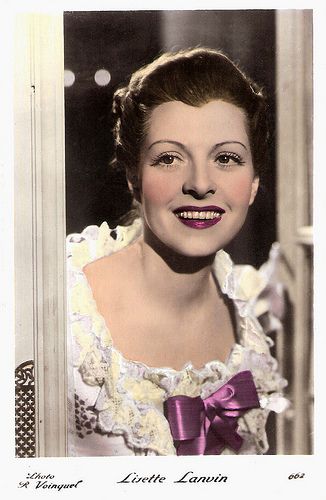
French postcard, no. 662. Photo: Raymond Voinquel.
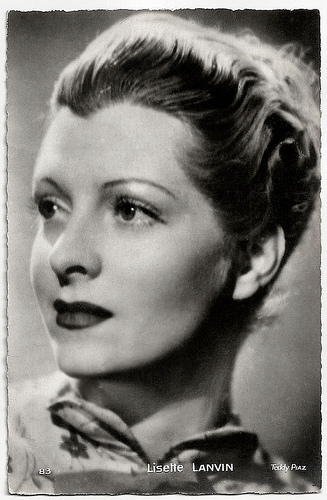
French postcard by Editions P.O., Paris, no. 83. Photo: Teddy Piaz.
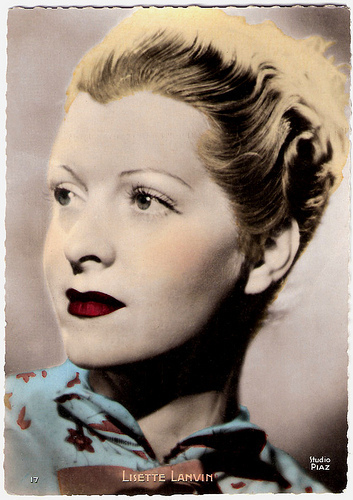
French postcard by Editions P.I., Paris, no. 17. Photo: Studio Piaz.
The Love Of Her Life
In the following years, Lisette Lanvin pursued a successful career with many comedies. Notable was Nitchevo (Jacques de Baroncelli, 1935), the name of a smuggling ship on which two naval officers (Harry Baur and Georges Rigaud) fall in love with the same woman. Then she played the daughter of the unsavoury Françoise Rosay in Jenny (Marcel Carné, 1936), who competes with her mother for the love of gangster Albert Prejean. By now, Lanvin had made a name for herself and Sacha Guitry gave her parts in Perles de la couronne/Pearls of the Crown (1937) and Remontons les Champs-Élysées/Go back to the Champs Elysées (1938). Lanvin also appeared in unpretentious comedies like Les Rois du sport/Kings of Sport (Pierre Colombier, 1937) alongside Raimu, Fernandel and Jules Berry, and she played the wife of Charles Boyer in Orage/Storm (Marc Allégret, 1938). In 1939, she played only in one film, La Brigade sauvage/Savage Brigade (Jean Dréville, Marcel L’Herbier, 1939). She played the daughter of Charles Vanel and Véra Korène in the Parisian milieu of Russian emigrants. In real life she became that year Mrs Guy Mortier. Her husband, a lieutenant with no connection to the film business, then mobilized. Guy Mortier would be the love of her life. During the war, Lanvin completely disappeared from the film scene. After the war she returned to make two more films. Her thirtieth and last feature was La Route inconnue/The Unknown Road (Léon Poirier, 1948) about life among the Tuareg of Charles de Foucauld (1858-1916), the future Catholic martyr and saint, played by Robert Darène. At 35, Lisette Lanvin decided to finish her career. In 2004, she died in Suresnes, France. She was 90.
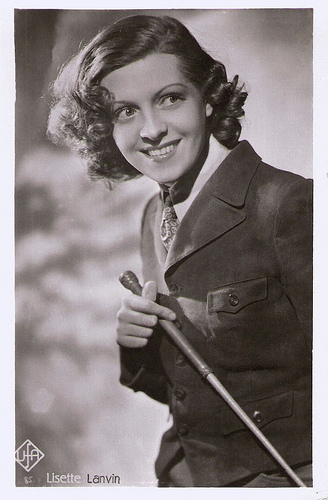
French postcard, Paris, no. 85. Photo: Ufa.
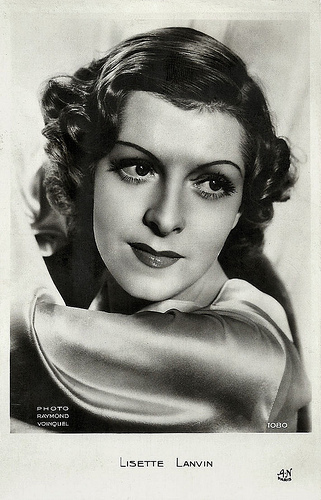
French postcard by A.N., Paris, no. 1080. Photo: Raymond Voinquel.
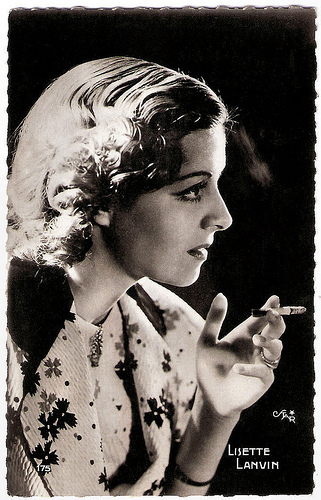
French postcard by Editions P.I., Paris, no. 175. Photo: Star.
Sources: Caroline Hanotte (CinéArtistes) (French), Philippe (CinéMémorial) (French), Films de France, AllMovie, Wikipedia (French) and

French postcard by Erpé, Paris, no. 61. Photo: Star.
Full of Surprises
Lisette Lanvin was born Elisabeth Etiennette Marie Caremil in Grasse, France in 1913. She was the daughter of Auguste Caremil, a cook, and Marie Ricorda. Less than two years later her father died in the war. With dreams of becoming an actress, Lanvin went to Paris. There she became a receptionist in a fashion house. In 1931, she landed a small role in the film operetta La Chauve-souris/Die Fledermaus/The Bat (Carl Lamac, 1931), based on the operetta by Johan Strauss jr. The film was co-produced with the German company Ondra-Lamac-Film created by director Lamas and his wife actress Anny Ondra. Ondra played the lead alongside Iván Petrovich. Her next film was Rouletabille aviateur/Rouletabille Aviator (1932). Caroline Hanotte at CinéArtistes : “Director was the Hungarian István Székely, better known under his Anglo-Saxon name Steve Sekely. He shot the film in his homeland where Roland Toutain, aka journalist Rouletabille spends his holidays. There he meets Lisette, daughter of Police Commissioner Bathory. The couple soon goes in search of gold bars stolen by gangsters. Far from being a masterpiece, the film is full of surprises. One can see the planes and Budapest in the thirties. The energy and bright smiles of the young heroes do the rest.” In 1932, Lanvin made five more films, including the thriller Le Chien jaune/The Yellow Dog (Jean Tarride, 1932) with Abel Tarride as Commissioner Maigret, Mon curé chez les riches/My pastor among the rich (Donatien, 1932) with Pauline Carton, and Je vous aimerai toujours/I Will Love You Always (Mario Camerini, Henri Decoin, 1932), again a leading role.

French postcard, no. 662. Photo: Raymond Voinquel.

French postcard by Editions P.O., Paris, no. 83. Photo: Teddy Piaz.

French postcard by Editions P.I., Paris, no. 17. Photo: Studio Piaz.
The Love Of Her Life
In the following years, Lisette Lanvin pursued a successful career with many comedies. Notable was Nitchevo (Jacques de Baroncelli, 1935), the name of a smuggling ship on which two naval officers (Harry Baur and Georges Rigaud) fall in love with the same woman. Then she played the daughter of the unsavoury Françoise Rosay in Jenny (Marcel Carné, 1936), who competes with her mother for the love of gangster Albert Prejean. By now, Lanvin had made a name for herself and Sacha Guitry gave her parts in Perles de la couronne/Pearls of the Crown (1937) and Remontons les Champs-Élysées/Go back to the Champs Elysées (1938). Lanvin also appeared in unpretentious comedies like Les Rois du sport/Kings of Sport (Pierre Colombier, 1937) alongside Raimu, Fernandel and Jules Berry, and she played the wife of Charles Boyer in Orage/Storm (Marc Allégret, 1938). In 1939, she played only in one film, La Brigade sauvage/Savage Brigade (Jean Dréville, Marcel L’Herbier, 1939). She played the daughter of Charles Vanel and Véra Korène in the Parisian milieu of Russian emigrants. In real life she became that year Mrs Guy Mortier. Her husband, a lieutenant with no connection to the film business, then mobilized. Guy Mortier would be the love of her life. During the war, Lanvin completely disappeared from the film scene. After the war she returned to make two more films. Her thirtieth and last feature was La Route inconnue/The Unknown Road (Léon Poirier, 1948) about life among the Tuareg of Charles de Foucauld (1858-1916), the future Catholic martyr and saint, played by Robert Darène. At 35, Lisette Lanvin decided to finish her career. In 2004, she died in Suresnes, France. She was 90.

French postcard, Paris, no. 85. Photo: Ufa.

French postcard by A.N., Paris, no. 1080. Photo: Raymond Voinquel.

French postcard by Editions P.I., Paris, no. 175. Photo: Star.
Sources: Caroline Hanotte (CinéArtistes) (French), Philippe (CinéMémorial) (French), Films de France, AllMovie, Wikipedia (French) and
Published on July 12, 2013 02:06
July 10, 2013
Pascale Petit
In the late 1950s, sweet and sexy French actress Pascale Petit (1938) formed serious competition for Brigitte Bardot as The Sex Symbol of the French cinema.
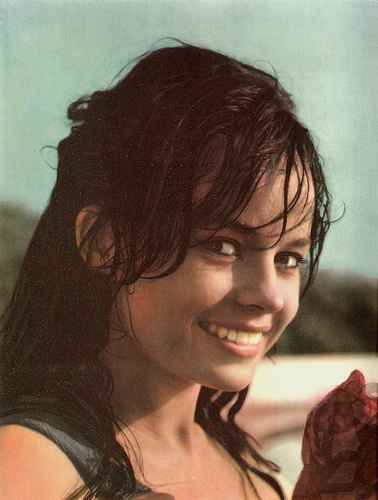
Vintage postcard.
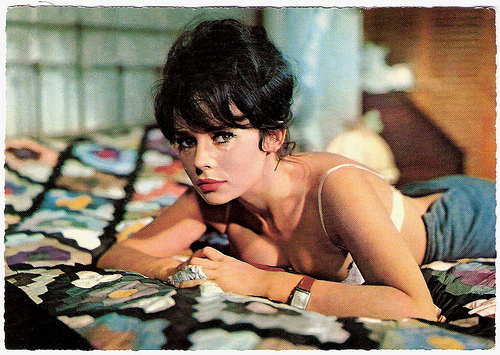 German postcard by Krüger, no. 902/65.
German postcard by Krüger, no. 902/65.
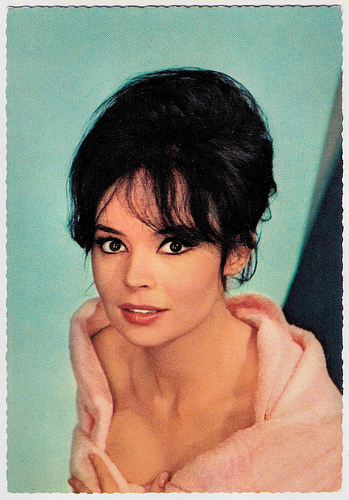
German postcard by Krüger, no. 902/90. Photo: Sam Lévin.
Seductive Femme Fatale
Pascale Petit was born as Anne-Marie Petit in Paris, France in 1938. Before becoming an actress, she worked as a beautician. Her cinema debut was in Les Sorcières de Salem/The Crucible (Raymond Rouleau, 1957) starring Yves Montand and Simone Signoret. Famous author Jean-Paul Sartre wrote the screenplay, based on the play by Arthur Miller. The following year, Pascale Petit's role as a rich, existentialist kid in Les tricheurs/The Cheaters (Marcel Carné, 1958) made her a star. A scene in which one of her breasts was shown caused a sensation. Hal Erickson notes at AllMovie : "Of the cast, Pascale Petit stands out as a trendy young girl whose willingness to follow the crowd leads to tragedy." She won the prestigious Prix Suzanne Bianchetti in 1958 as the most promising French actress, and soon more roles as a seductive femme fatale followed.
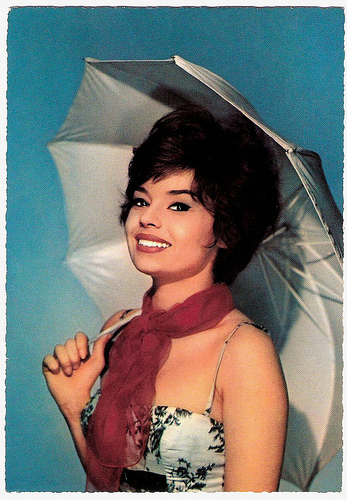
German postcard by Krüger, no. 902/89. Photo: Sam Levin.
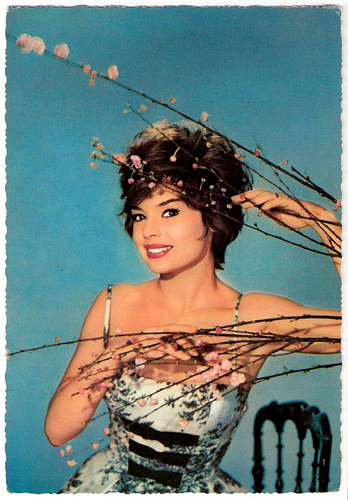
German postcard by Krüger, no. 902/88. Photo: Sam Lévin.
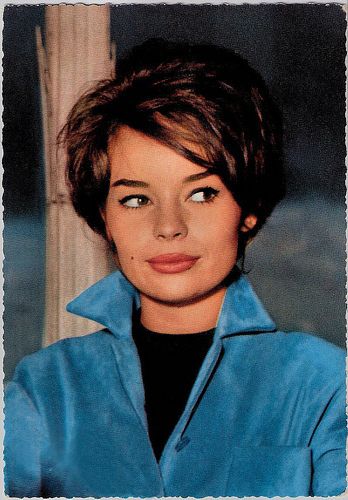
German postcard by Krüger, no. 902/160. Photo: Fried Agency / Ufa.
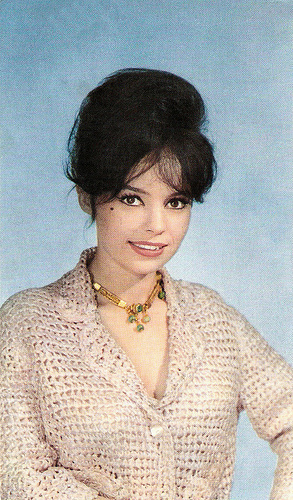
French postcard by PSG, no. 33, offered by Corvisart. Photo: Lucienne Chevert.
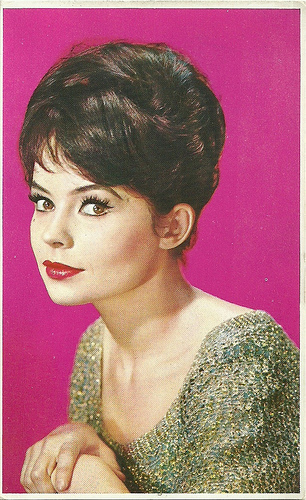
French postcard by Editions P.I., Paris, no. 1067, offered by Corvisart, Epinal. Photo: Sam Lévin.
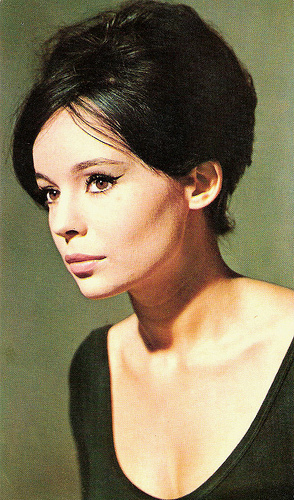
French postcard by PSG, no. 70, offered by Corvisart. Photo: Sam Lévin.
German and Italian B pictures
Pascale Petit played in such comedies as Faibles femmes/Three Murderesses (Michel Boisrond, 1959) with Alain Delon and Mylène Demongeot, and Une fille pour l'été/A girl for the Summer (Edouard Molinaro, 1960) opposite Micheline Presle. For a while the media compared her to Brigitte Bardot. In 1959 PP married poet and actor Giani Esposito and followed him to Italy. In the 1960s she was mainly seen in German and Italian B pictures, such as the Spaghetti Western Joe... cercati un posto per morire!/Find a Place to Die (Giuliano Carnimeo, 1968) with Jeffrey Hunter. In 1969 she divorced Esposito and married actor Ray Denton, her co-star of the spy thriller Corrida pour un espion/Code Name: Jaguar (Maurice Labro, 1965).
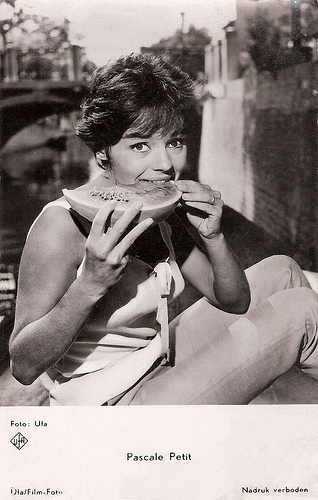
Dutch postcard by Gebr. Spanjersberg N.V., Rotterdam, no. 1239. Photo: Ufa, Berlin-Tempelhof.
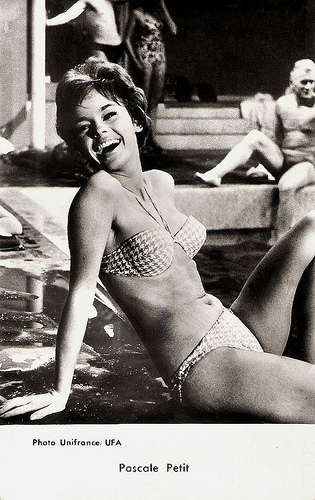
French postcard by Editions P.I., Paris, no. FK 29. Photo: Unifrance / Ufa.
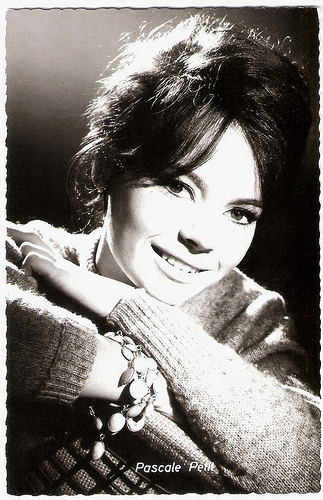
German postcard by Kolibri-Verlag, Minden/Westf., no. 1295.
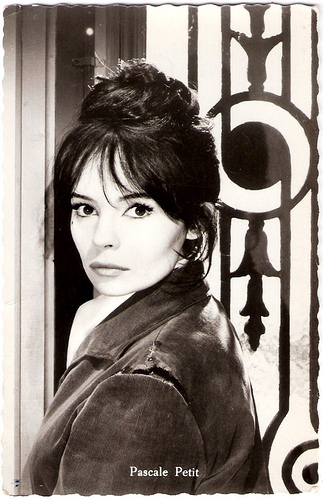
Dutch postcard, ca. 1961.
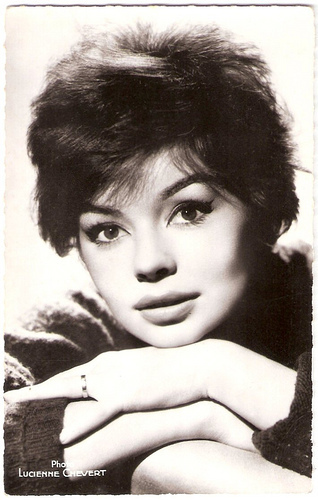
French postcard by Editions du Globe, Paris, no. 807. Photo: Lucienne Chevert.
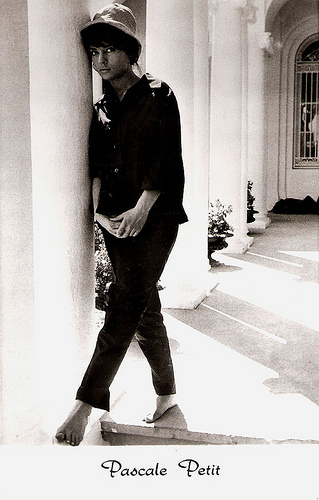
Dutch postcard by Gebr. Spanjersberg, Rotterdam, no. 5543.
Delicious Dutch Gem
In the early 1970s Pascale Petit tried to make a comeback in France, as well in the cinema with Chronique d'un Couple.../Chronicle of a Couple (Roger Coggio, 1971) as in the music scene with Il ne reste que moi.../What's Left is Me (1973). The success was lukewarm and in the following decades she worked as a character actress in unremarkable international films and TV productions. Interesting were a small, delicious Dutch gem, A Strange Love Affair (Eric De Kuyper, Paul Verstraten, 1984), and two TV films by Brigitte Bardot's Svengali - Roger Vadim, the mini-series La nouvelle tribu/The new tribe (1996), and Un coup de baguette magique/A magic wand (1997), both featuring Marie-Christine Barrault. Pascale Petit has a daughter, Douchka, from her marriage with Giani Esposito.
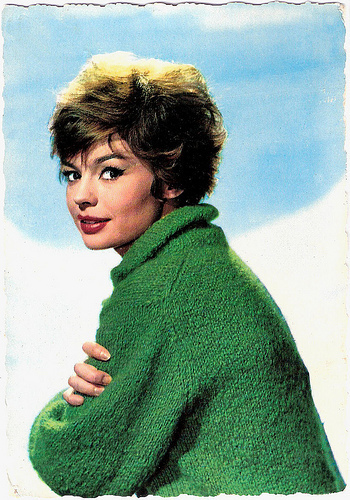
French postcard by E.D.U.G., no. 64. Photo: Sam Lévin.
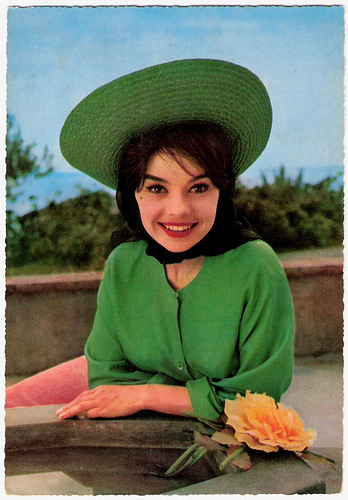
German postcard by Krüger, no. 902/44.
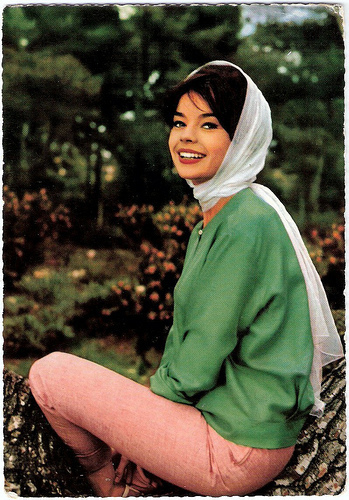
German postcard by Krüger, ca. 1961.
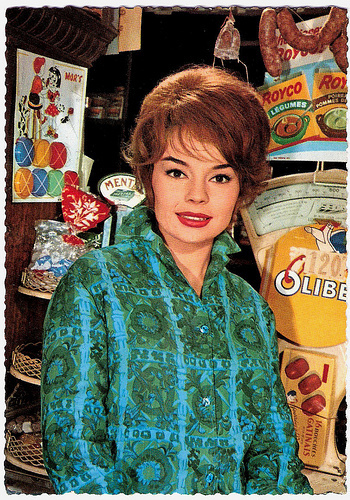
German postcard by Krüger, no. 902/134. Photo: Ufa.
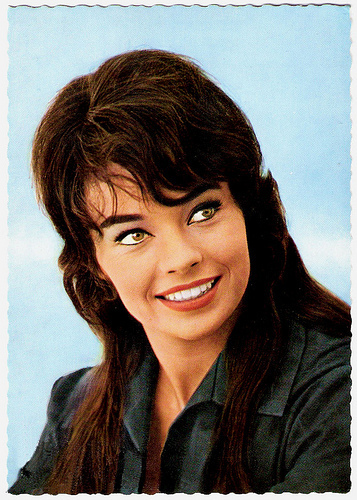
German postcard by Ufa, Berlin-Tempelhof, no. CK 341. Retail price: 30 Pfg. Photo: Gérard Decaux / Ufa.
Scene from Les Tricheurs with Jean-Paul Belmondo and Pascale Petit.
Sources: Hal Erickson (AllMovie), AllMovie, Wikipedia and

Vintage postcard.
 German postcard by Krüger, no. 902/65.
German postcard by Krüger, no. 902/65.
German postcard by Krüger, no. 902/90. Photo: Sam Lévin.
Seductive Femme Fatale
Pascale Petit was born as Anne-Marie Petit in Paris, France in 1938. Before becoming an actress, she worked as a beautician. Her cinema debut was in Les Sorcières de Salem/The Crucible (Raymond Rouleau, 1957) starring Yves Montand and Simone Signoret. Famous author Jean-Paul Sartre wrote the screenplay, based on the play by Arthur Miller. The following year, Pascale Petit's role as a rich, existentialist kid in Les tricheurs/The Cheaters (Marcel Carné, 1958) made her a star. A scene in which one of her breasts was shown caused a sensation. Hal Erickson notes at AllMovie : "Of the cast, Pascale Petit stands out as a trendy young girl whose willingness to follow the crowd leads to tragedy." She won the prestigious Prix Suzanne Bianchetti in 1958 as the most promising French actress, and soon more roles as a seductive femme fatale followed.

German postcard by Krüger, no. 902/89. Photo: Sam Levin.

German postcard by Krüger, no. 902/88. Photo: Sam Lévin.

German postcard by Krüger, no. 902/160. Photo: Fried Agency / Ufa.

French postcard by PSG, no. 33, offered by Corvisart. Photo: Lucienne Chevert.

French postcard by Editions P.I., Paris, no. 1067, offered by Corvisart, Epinal. Photo: Sam Lévin.

French postcard by PSG, no. 70, offered by Corvisart. Photo: Sam Lévin.
German and Italian B pictures
Pascale Petit played in such comedies as Faibles femmes/Three Murderesses (Michel Boisrond, 1959) with Alain Delon and Mylène Demongeot, and Une fille pour l'été/A girl for the Summer (Edouard Molinaro, 1960) opposite Micheline Presle. For a while the media compared her to Brigitte Bardot. In 1959 PP married poet and actor Giani Esposito and followed him to Italy. In the 1960s she was mainly seen in German and Italian B pictures, such as the Spaghetti Western Joe... cercati un posto per morire!/Find a Place to Die (Giuliano Carnimeo, 1968) with Jeffrey Hunter. In 1969 she divorced Esposito and married actor Ray Denton, her co-star of the spy thriller Corrida pour un espion/Code Name: Jaguar (Maurice Labro, 1965).

Dutch postcard by Gebr. Spanjersberg N.V., Rotterdam, no. 1239. Photo: Ufa, Berlin-Tempelhof.

French postcard by Editions P.I., Paris, no. FK 29. Photo: Unifrance / Ufa.

German postcard by Kolibri-Verlag, Minden/Westf., no. 1295.

Dutch postcard, ca. 1961.

French postcard by Editions du Globe, Paris, no. 807. Photo: Lucienne Chevert.

Dutch postcard by Gebr. Spanjersberg, Rotterdam, no. 5543.
Delicious Dutch Gem
In the early 1970s Pascale Petit tried to make a comeback in France, as well in the cinema with Chronique d'un Couple.../Chronicle of a Couple (Roger Coggio, 1971) as in the music scene with Il ne reste que moi.../What's Left is Me (1973). The success was lukewarm and in the following decades she worked as a character actress in unremarkable international films and TV productions. Interesting were a small, delicious Dutch gem, A Strange Love Affair (Eric De Kuyper, Paul Verstraten, 1984), and two TV films by Brigitte Bardot's Svengali - Roger Vadim, the mini-series La nouvelle tribu/The new tribe (1996), and Un coup de baguette magique/A magic wand (1997), both featuring Marie-Christine Barrault. Pascale Petit has a daughter, Douchka, from her marriage with Giani Esposito.

French postcard by E.D.U.G., no. 64. Photo: Sam Lévin.

German postcard by Krüger, no. 902/44.

German postcard by Krüger, ca. 1961.

German postcard by Krüger, no. 902/134. Photo: Ufa.

German postcard by Ufa, Berlin-Tempelhof, no. CK 341. Retail price: 30 Pfg. Photo: Gérard Decaux / Ufa.
Scene from Les Tricheurs with Jean-Paul Belmondo and Pascale Petit.
Sources: Hal Erickson (AllMovie), AllMovie, Wikipedia and
Published on July 10, 2013 23:00
July 9, 2013
Amleto
The Italian silent production Amleto/Hamlet (Eleuterio Rodolfi, 1917) is one of two hundred or more Shakespeare films that were made in the silent period of cinema. Film historian Luke McKernan introduced a screening of the film at the Notre Dame Shakespeare Festival in 2004: "it is a good and interesting film. Not a great film, but arguably the best silent Shakespeare film that exists."
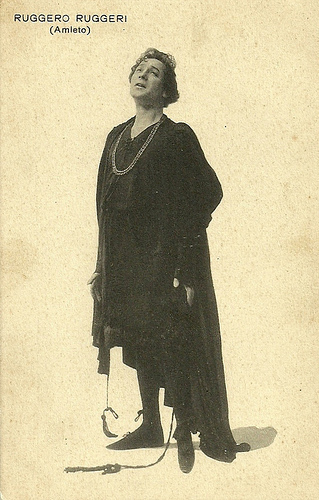
Italian postcard, no. 8067. Photo: Ruggero Ruggeri as Hamlet/Amleto, either on stage or in the film Amleto (Eleuterio Rodolfi, 1917).
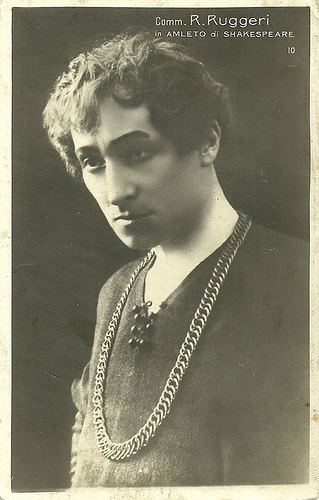
Italian postcard. Editor unknown.
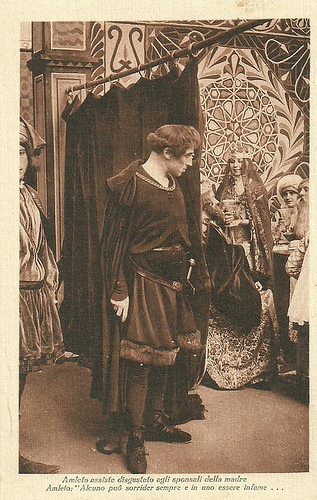
Italian postcard. Ruggero Ruggeri as Hamlet and Mercedes Brignone as Queen Gertrude in Amleto/Hamlet (Eleuterio Rodolfi, 1917). Caption: "Disgusted Hamlet assists to the wedding of his mother. Hamlet: 'That one may smile, and smile, and be a villain.'" (Though these are Shakespeare's words, in the play however, Gertrude is already remarried.)
Triumph
The title role of Amleto/Hamlet was played by Ruggero Ruggeri, one the most important Italian actors of the first half of the twentieth century. Before making the film, he had already triumphed in a stage production of Hamlet. Amleto was his third film. Helena Makowska played Ophelia, and Mercedes Brignone, who is particularly good in the film, played Gertude. Armand Pouget was the Ghost of Hamlet’s father, Gerardo Pena played Laertes, and Martelli played Claudius. The film was released in Italy, and after the war also in France, Britain and the US. Luke McKernan: "Amleto made under economic circumstances very different to the pre-war period when Italian epics conquered the world cinema market. It is an altogether more modest production; though not an impoverished one as such. It is certainly a film that needs to be much better known."
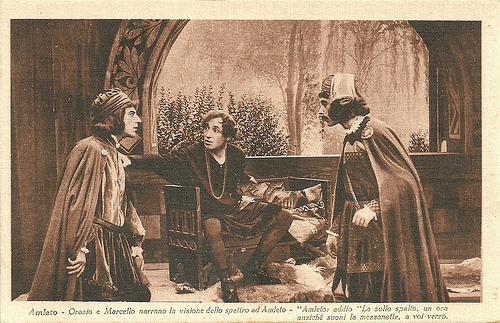
Italian postcard. Ruggero Ruggeri as Hamlet in Amleto/Hamlet (Eleuterio Rodolfi, 1917). Translation caption: "Horatio and Marcellus tell Hamlet of their vision of the ghost. Hamlet responds (Shakespeare's words): 'Upon the platform, 'twixt eleven and twelve, I'll visit you.'"
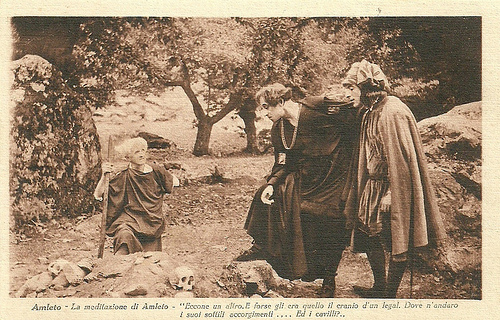
Italian postcard. Ruggero Ruggeri as Hamlet in Amleto/Hamlet (Eleuterio Rodolfi, 1917). Caption: "Hamlet's meditation: 'There's another: why may not that be the skull of a lawyer? Where be his quiddities now, his quillets, his cases, his tenures, and his tricks?'"
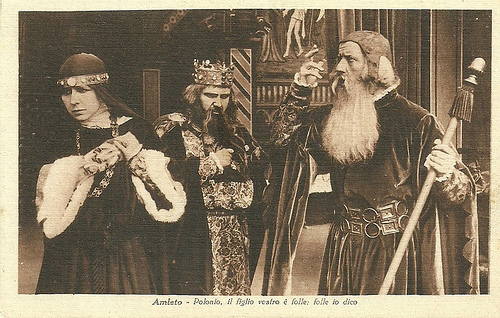
Italian postcard. Mercedes Brignone as Queen Gertrude and Armand Pouget as King Claudius in Amleto/Hamlet (Eleuterio Rodolfi, 1917). Caption: "Polonius: 'Your noble son is mad. Mad call I it.'"
Sources: Luke McKernan, and IMDb.

Italian postcard, no. 8067. Photo: Ruggero Ruggeri as Hamlet/Amleto, either on stage or in the film Amleto (Eleuterio Rodolfi, 1917).

Italian postcard. Editor unknown.

Italian postcard. Ruggero Ruggeri as Hamlet and Mercedes Brignone as Queen Gertrude in Amleto/Hamlet (Eleuterio Rodolfi, 1917). Caption: "Disgusted Hamlet assists to the wedding of his mother. Hamlet: 'That one may smile, and smile, and be a villain.'" (Though these are Shakespeare's words, in the play however, Gertrude is already remarried.)
Triumph
The title role of Amleto/Hamlet was played by Ruggero Ruggeri, one the most important Italian actors of the first half of the twentieth century. Before making the film, he had already triumphed in a stage production of Hamlet. Amleto was his third film. Helena Makowska played Ophelia, and Mercedes Brignone, who is particularly good in the film, played Gertude. Armand Pouget was the Ghost of Hamlet’s father, Gerardo Pena played Laertes, and Martelli played Claudius. The film was released in Italy, and after the war also in France, Britain and the US. Luke McKernan: "Amleto made under economic circumstances very different to the pre-war period when Italian epics conquered the world cinema market. It is an altogether more modest production; though not an impoverished one as such. It is certainly a film that needs to be much better known."

Italian postcard. Ruggero Ruggeri as Hamlet in Amleto/Hamlet (Eleuterio Rodolfi, 1917). Translation caption: "Horatio and Marcellus tell Hamlet of their vision of the ghost. Hamlet responds (Shakespeare's words): 'Upon the platform, 'twixt eleven and twelve, I'll visit you.'"

Italian postcard. Ruggero Ruggeri as Hamlet in Amleto/Hamlet (Eleuterio Rodolfi, 1917). Caption: "Hamlet's meditation: 'There's another: why may not that be the skull of a lawyer? Where be his quiddities now, his quillets, his cases, his tenures, and his tricks?'"

Italian postcard. Mercedes Brignone as Queen Gertrude and Armand Pouget as King Claudius in Amleto/Hamlet (Eleuterio Rodolfi, 1917). Caption: "Polonius: 'Your noble son is mad. Mad call I it.'"
Sources: Luke McKernan, and IMDb.
Published on July 09, 2013 23:00
Paul van Yperen's Blog
- Paul van Yperen's profile
- 13 followers
Paul van Yperen isn't a Goodreads Author
(yet),
but they
do have a blog,
so here are some recent posts imported from
their feed.



